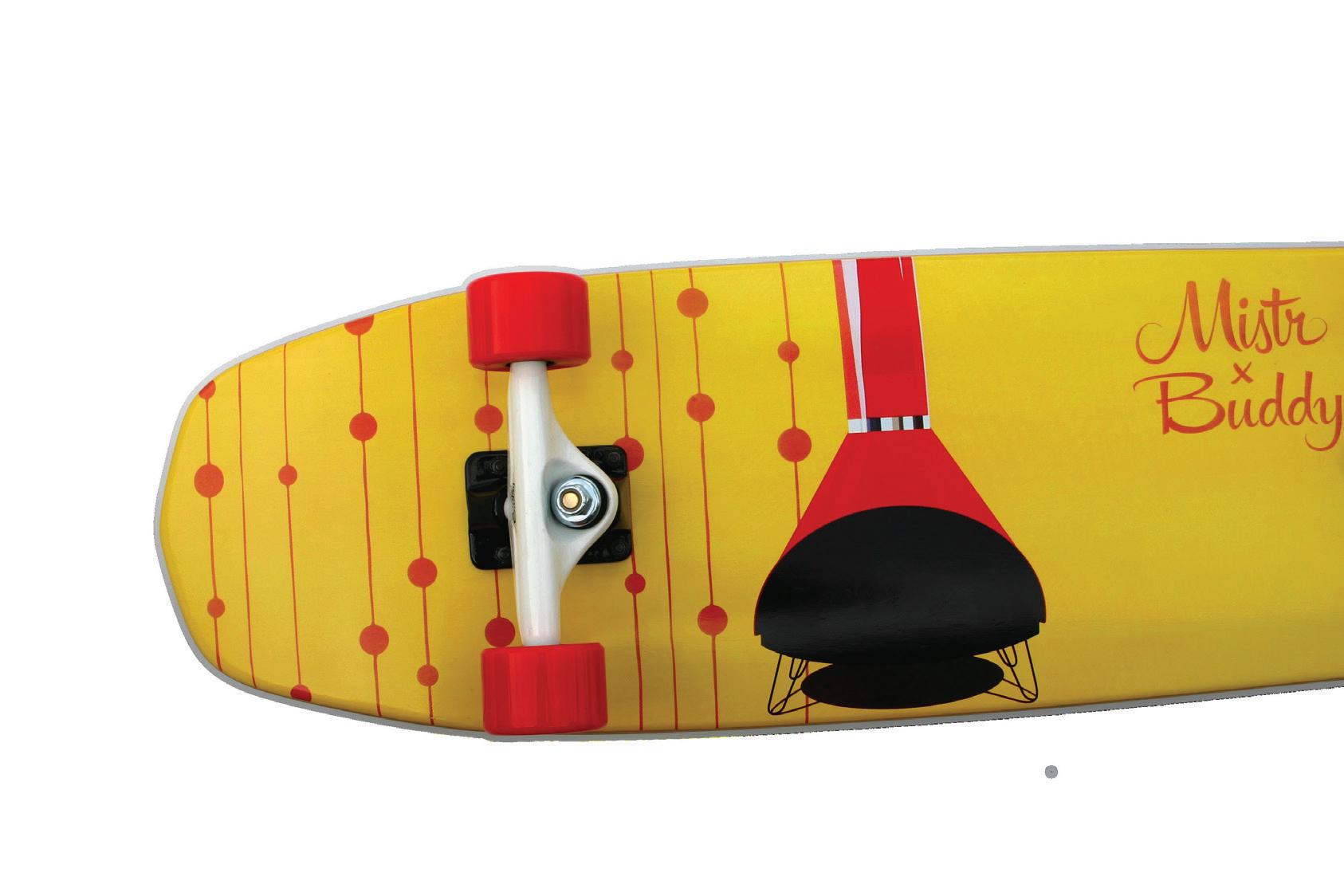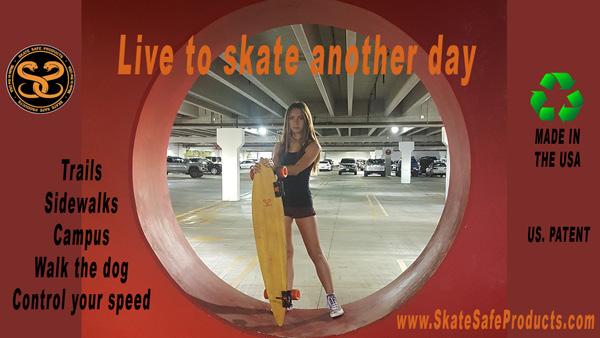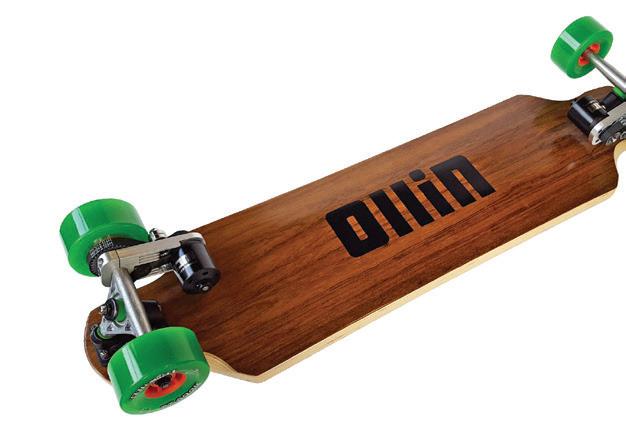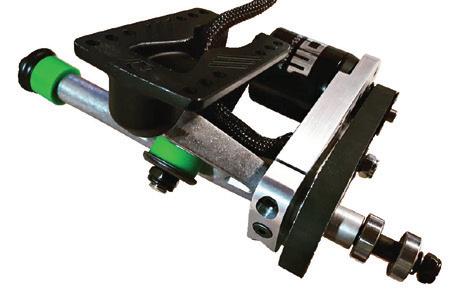









DISTILLING A GLOBAL CREW OF ORIGINALS





































































Publisher/Editor: Michael Brooke
Executive Editor: Bud Stratford
Copy Editor: Jonathan Harms
Art Director/Designer: Stacy Lowery
Associate Editors: Joseph Friedman, Daniel Fedkenheuer
Web Development: Rick Tetz
PRINTED




BONES
29.5”/30”/30.5”/31” Wheelbase Options
With the help of team rider, Malachi Greene, we developed the Dusters Bones, a true downhill machine. Constructed with a custom shape, W-Concave, slight rocker, multiple truck mounting options, routered wheel wells and a 10-ply veneer layup, this board was built for speed and feel. We also used extra coarse printed grip tape to give the rider more control over the board. Finally, we paired this bad boy with all new 70mm 78A Gliders wheels, designed by Dusters for smoother slides while still keeping a grip in tight turns. If you’re a downhill fiend, the Bones complete will not let you down!
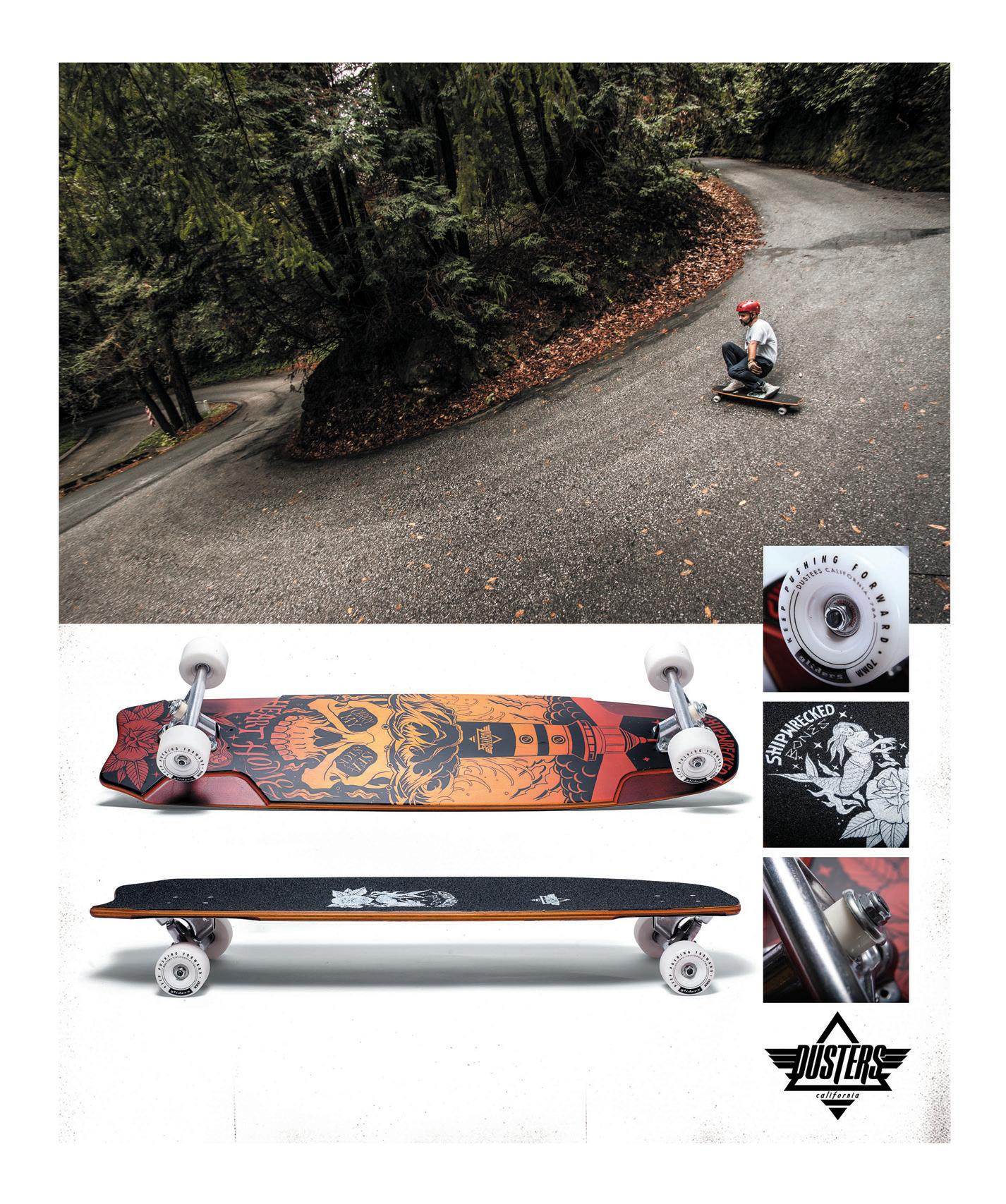

Welcome to the Fine Print. Of all the things Concrete Wave creates, this is one feature that I sense both delights and confuses readers. I think the first time I ever wrote anything here was Vol. 1 No. 5. That’s the cover with David Hackett. Over the years, Dave has never been shy to let me know exactly how he feels about the magazine. I know I must have driven him crazy on a few occasions. Come to think of it, there’s probably a few people who’ve had some issues with the magazine. Well, Dave, I can assure you things are taking a decidedly different step forward starting with the next issue. You’ll have to wait until September to see how things look, but my gut tells me you’ll be pleasantly surprised.
Many people take a cursory look at this page, have a quick peek at the artwork and move on. As you can imagine, each piece of art on this page has a story. All elicit a great response. I am fortunate to work with some truly incredible artists. A number, like Montreal’s Chris Dyer, have flourishing careers in the challenging world of art. I am proud of the fact that CW was one of the first magazines to feature Chris’s artwork, but I am even prouder to call him a friend. This issue features a cover story on Jamaica, and this image was the best way to pay tribute to one of Jamaica’s greatest exports, Bob Marley. I think if he’d had the chance, Bob would have ridden a skateboard.
For those people who have read this feature throughout the years, I want to acknowledge your attention. I know very well that you could rush into the magazine and skip this piece. So thanks for taking the time. For those who are new to this column, the Fine Print is a mixture of my stream of consciousness and the occasional tidbit of info. In terms of info, well, here’s something: This is my last Fine Print as editor-in-chief. No need to panic, I am still the publisher, but as you can probably guess, there is change in the air. I’ve hired Bud Stratford to take on the role of executive editor. This means he gets to take on most the editorial reins. I’ll still have my imprint on this publication, but when it comes to an editorial voice within this column and the formal editorial page, starting with our September issue, the words will be from Bud. I will of course be contributing features and floating ideas around. I’ll also be involved with a number of surprising events. Take to Facebook and find out more.
Skateboarding rides a cycle of popularity that to some seems quite fickle and utterly incomprehensible. But the truth is that there are patterns to these cycles within skateboarding. As Norm MacDonald (of Ultimate Distributors fame) once astutely told me, “When skateboarding is ‘out’ it is ‘in,’ and when it is ‘in’ it is ‘out.’” As skateboarding starts to ride the wave to the 2020 Olympics, you will see an explosion of interest from all corners of the globe. Areas that at one time would never consider skateboarding might just come on board. Undoubtedly this will propel things forward in ways Fausto Vitello couldn’t even consider. (Not sure who Fausto is? Better turn to Google, pronto.) Parents will now have a plausible framework to comprehend skateboarding: “Practice, kid! You’ve got a chance at the Olympics one day!” Skateboarding at the Olympics was first proposed for the Moscow Games in 1980. The USA boycott of those games led to a Russian boycott of the Los Angeles games in 1984. With all the geopolitical crap going on these days, don’t you wish games were the only way that countries could figure out their issues with each other?
In this issue you will read about our adventures in Jamaica. I will never forget that trip, and I owe a huge amount to Brady Brown and his family along with Luis Bustamante and his pal Sampson. I sense I will be returning to Jamaica sooner than later. In that spirit, I’d like to dedicate this issue to all the Jamaicans who have inspired me with their music and their passion for life. Thank you for your hospitality, Jamaica. I intend to pay you back as much as I can. A final shout out to Ray, Doug and Luke of the Shralper’s Union. Wishing you all high fives and positive vibes.
This issue is dedicated to Ty Page aka Mr. Incredible 1958 -2017.
It’s hard to believe that we’ve arrived at Vol. 16 No. 1. Precisely 15 years ago this June, I found myself in Folly Beach, South Carolina, at a slalom competition. A box containing copies of our very first issue arrived for the event, and I recall watching people’s reactions. We’d put Duane Peters on the cover and declared that Concrete Wave was here to take you back and move you forward. Duane was certainly a pioneer in skateboarding, but I’d like to take this opportunity to acknowledge a few other people who carved the way for generations of skaters.
Let’s start with the early 1960s. George Trafton, Steve and Davey Hilton rode backyard pools on clay wheels. Hard to believe they hit coping, but indeed they did. In that same decade, Hobie Alter teamed up with the Vita-Pakt juice company to create a renowned skate team. What many people don’t know is that Hobie and the team experimented with rubber wheels.



Who knows what could have happened had they just had the foresight of Frank Nasworthy, who would go on to promote urethane wheels less than a decade later. In the 1970s, downhill speeds were officially clocked at 50+ mph. But unofficially, things were considerably faster. Roberto “Chuy” Madrigal bombed Knoll Ranch Road in Anaheim Hills and is said to have hit 70+ mph.
Nowadays, female skaters are receiving a great deal of welldeserved coverage. But over 40 years ago, SkateBoarder magazine had no problem showcasing female skaters. Laura Thornhill’s eight-page interview in the December 1976 issue paved the way for numerous female skaters. Laura was also a key part of the trip to the Arizona desert pipes in SkateBoarder’s Spring 1977 issue – the first time a mix of male and female skaters were featured on a road trip in a skate magazine. When skate and snowboard pioneer Lonnie Toft came up to the Toronto Sportsmen’s Show, he met up with “Wee Willi” Winkels.
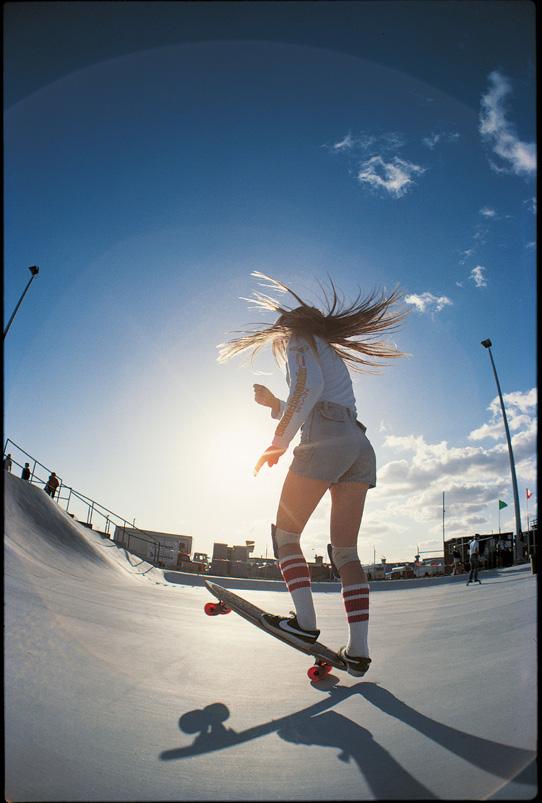
Lonnie took one of Willi’s laminated decks back to California and won a contest with it. This got the attention of board maker Tom Sims, and laminated boards soon became the standard. For the record, Willi also had a hand in developing the halfpipe and the world’s first portable music system you could ride with.

Randal Fuller came up with the reverse-kingpin truck almost four decades ago. He took his designs to Sure-Grip, who manufactured the trucks. It took a considerable amount of time for the skate world to understand Randal’s vision, but his design set the standard. Back in the early 1990s, Dennis Telfer took an old snowboard and turned it into a longboard. Unfortunately, the board got stolen, but it encouraged Dennis to make additional decks for friends. The demand became so intense that Dennis eventually co-founded Sector 9.
In 1994, Dan Gesmer of Seismic ran an ad in TransWorld Skateboarding promoting turning and carving. At the time this was seen as completely unorthodox and somewhat crazy. Now, in hindsight, you can see just how far ahead of his time Dan actually was.
There are literally dozens of additional stories that we could add to this piece. These stories are just a small sampling of the tremendously rich history of skateboarding. The beauty of history is that it gives us perspective and can at times offer us clues to the future. If these last 15 years are any indication of what’s to come, I know it’s going to be an incredible ride.



Zenit boards are handcrafted in their own workshop in downtown Montreal. They use Grade A certified hard rock Canadian maple, high-end epoxy resin, multiple types of carbon fiber/fiberglass and several exotic wood essences. From classic cruisers to freeride boards up to DKs and dancing boards, Zenit has something for everyone to enjoy.. zenitboards.com
As the Shralpers Union continues to spread high fives and positive vibes and the legend of Noel Korman continues to echo from coast to coast, the Union has decided to dedicate a portion of its designs to its founder. Working with several artists, the Union is visiting Noel’s past and integrating iconic designs from skate history with Noel’s amazing story. These limited items (shirts, hats, decks, stickers) will only be available at Shralpers Union shops and the Union website. With future limited releases to follow, they hope to capture the essence of Noel’s lifestyle and tell his story through art and design.
shralpersunion.nationbuilder.com


Landyachtz cast their line and reeled in a 28.5” trophy. New for summer 2017, the Dinghy Trout features a redesigned swallowtail shape and embossed scale graphic. It comes complete with 63 mm yellow swirl Fatty Hawgs and Polar Bear 105 mm trucks. landyachtz.com






The second release in the collaborative Nixon x Powell-Peralta series introduces six variations of the bestselling Time Teller model featuring graphics from the Bones Brigade team, including Tony Hawk, Rodney Mullen, Steve Caballero, Lance Mountain, Tommy Guerrero and Mike McGill.

Raphael Therrien loves his Kraft Dinner. It’s all about speed and efficiency. Kebbek krafted him a pro model with this lifestyle at its core, only it won’t give you constipation. Set yourself free with a kicktail on your downhill deck. Like the hairdos of Kebbek’s Canadian forefathers, it’s all about business in the front and party in the back. So embrace your inner mullet, let loose and hop on the Raphael Therrien Crafty TopMount 36. kebbek.com
The collaborative watches are available individually or as a Collectors’ Gift Set. The gift set includes all six watches, packaged in a custom box signed by the six pros highlighted with the release. Individual watches retail for $125.00 and the Collectors’ Gift Set retails for $800.00. A free zine comes with each purchase, providing a deep dive into the story behind the iconic works and full interviews with the team, George Powell, Stacy Peralta and J. Grant Brittain. nixon.com
Almost five years ago, Longboarding for Peace met up with Grant Shilling from a nonprofit called Get on Board. Grant worked with Surfing for Peace, and LFP put him in touch with Landyachtz. Grant wrote a story about Ahousaht and he what experienced there. Landyachtz was so taken with the Ahousaht community that they decided to start a fundraising campaign to build a skatepark in 2015. In October of that year, Dwayne Mazereeuw of New Line Skateparks and his wife found themselves in Tofino, British Columbia. Here the story takes an unexpected turn. We had a chance to speak with Dwayne to find out what happened next.
The point that I knew we were in real trouble was when the boat tipped so far over that people started falling overboard. I kept thinking that the boat would tip back up – until I found myself in the water underneath the boat.
At the time you were visiting, Ahousaht was in the process of fundraising for a park. The expression “There are no coincidences” seems to come to mind. What is your take?
I still haven’t really been able to wrap my head around the whole thing. My wife and I had been trying to think of a meaningful way to thank the people that had come to our rescue and saved our lives. We were blown away when we found out that there was a group trying to get a skatepark built in Ahousaht. Given that I build skateparks for a living, it was the perfect opportunity to join forces with the Get on Board group, Landyachtz and the Ahousaht First Nation to help them get a skatepark built. It was a way for us to say thanks to all the Ahousaht responders in our rescue and help out a remote community that faces many challenges. So call it what you will – luck, a coincidence, aligning of the stars, fate or a higher power – all I know is that there was a whole spider web of unusual events that led up to our rescue and to this skatepark becoming a reality.
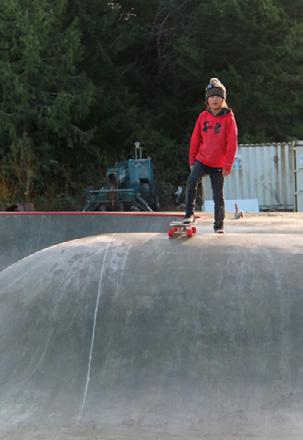
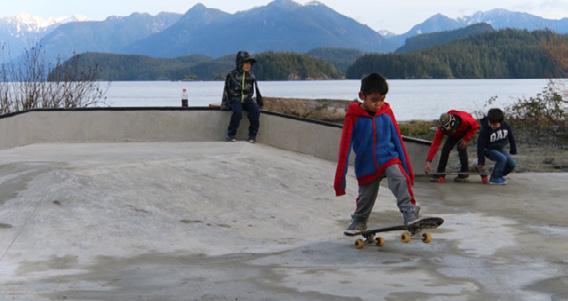
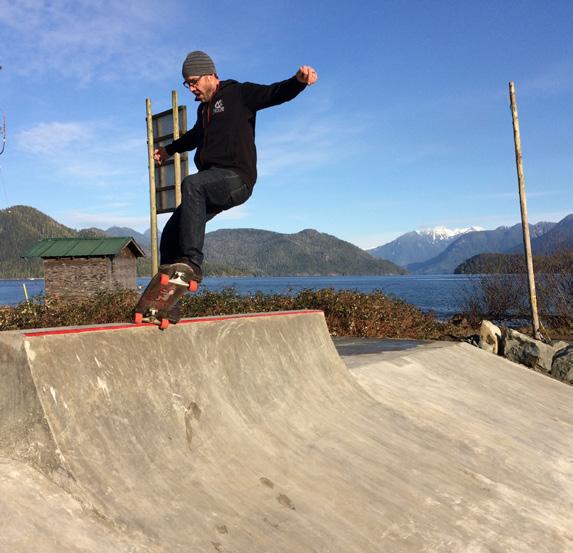

My wife and I were on a whale-watching tour while on a weekend getaway in Tofino. Our boat was struck by a wave and capsized. We were left to fend for our lives for over an hour in the rough and cold Pacific Ocean. It was an Ahousaht fisherman that saw the only flare that was set off that triggered a rescue. Several boats from the Ahousaht First Nation came out and rescued 21 survivors. Unfortunately six people lost their lives that day. If it wasn’t for the selfless efforts and quick action of the Ahousaht people, things would have been even worse.
What was New Line able to offer Ahousaht?
New Line jumped on board with the project right away. As a company we were celebrating our 15th year in business and were looking for some “give back” projects that we could support as part of our celebration. Given all the crazy circumstances, this project was a perfect fit as one of our 15-year celebration projects. New Line donated all design work for the park as well as over $30k worth of construction resources –labor, materials, equipment, etc. Some of our construction crew even volunteered some of their own time to help build the park. Landyachtz made a large financial contribution as well, and many companies and individuals donated money, time and supplies to help get the park built. It was a huge collaboration.
The reaction to the skatepark has been incredible. It’s been busy rain or shine. In such a remote community, the youth there have very few recreational facilities. Their biggest sport there is basketball, but as you and I know, team sports aren’t for everyone. Get on Board and Landyachtz have been continuing to do skate workshops through the schools in Ahousaht, and the feedback is that through skateboarding they are seeing amazing improvements in the engagement of the youth. I’m truly excited and thankful to have the opportunity to be involved in such a cool project, and can’t wait to see the impact it has on the youth there in the years to come.
Dwayne Mazereeuw checks out the park that he helped design.The noxious exhaust fumes and the clatter of self-absorbed business ants rushing around on the sidewalks below have vanished by the time I arrive. On the top floor of the parking garage in the middle of the night, I inhale a breath of cool air as I peer upwards at the shining metallic spires surrounding me that reach into the inky sky. The urban mountainscape is accented with green, blue and pink fluorescent reflections from the other buildings encroaching upward. It all looks much the same as it did 30 years ago when I first arrived in the Dallas/Fort Worth “Metroplex.”
However, on the top floor of the parking garage, now a giant sculpture of a chrome bird on a skateboard looks down at us – giving us some sense of entitlement to be here, even though we all know we are not really welcomed. Parking garages come and go, yet always remain. Gone are the old haunts with names like the Braniff, the Blue Rail and the Texas Club. Though
they still physically exist, they have become clogged with suffocating residential parking as more people move into downtown proper; or they are inaccessible due to higher security in these unpredictable times. But they have been replaced by other goliaths with monikers like Star, Mozart and Bat Cave. Other, lesser-known garages provide a guaranteed chase from security guards half my age – or even all-night hasslefree sessions, provided I don’t mind climbing stairs.
When I was young, the DFW parking garages were more the icing on the cake after a full day at the Clown Ramp or sweating it out in an empty swimming pool under the merciless Texas sun. They beckoned to us with their simplicity, the thrill of speed, the serious chance of injury and the promise of fun. We would make the pilgrimage once or twice a month, regular skateboards in hand. There was always the chance of running into local skateboard legends like Dan Wilkes or Craig Johnson on the elevator, themselves looking for the same kicks we were in search of. Dallas’ original longboarder, Tmo (RIP) or Dave Dude
were just as likely to be flying around a turn in the middle of the night upon our arrival, maybe doving a handstand for a full floor or catamarans to the bottom just for fun. The thrills were found in doing pack runs down the layers of floors and making the turns without a wholesale pile-up. It wasn’t really racing, as being at the front of the pack would have taken you out of the center of the storm, where the real fun was found. However much alike, a lot has changed since then …
Fueled in large part by the downhill zealots at Bombsquad Longboards, a burgeoning garage scene grew and manifested into a movement unto itself both locally and nationally. No longer do skaters hit a parking garage on a whim. Today it is a full-blown lifestyle practiced on a daily basis by the kind of speed freaks who don’t require a lab to get high. Shortboards with grounddown trucks have been replaced by longer wheelbases, precision trucks and grippy downhill wheels. Speed is king, and outlaw races are thrown regularly in DFW, other parts of Texas and across the country. Sometimes they’re thrown together with less than a day’s notice, sometimes with months of conspiring. The first garage race in Dallas that I recall was the product of an alcohol-fueled

debate between two guys over which of them was faster at a specific downtown parking garage. Bravado and pride cemented a mano a mano duel for the following weekend, with witnesses at the start and finish to keep things legit. One trophy was made from an Independent truck, a Tracker truck and a block of old fencepost. That original race was given
the unoriginal title “King of the Hill,” and for years after that, the original two competitors organized other downhill races that drew in racers from all over Texas.
Since that early challenge, things have taken off, perhaps inspired by the race, or just as likely completely unaware of it. Full-face racing helmets are now a common sight. The competition is heated in this city, and the local racers take pride in their consistent wins at garage races that have taken place all over the country. There is fierce sh*ttalking amongst the fastest that usually revolves around who has stood at the
top of the podium the most – even if the podium consists only of an empty ice chest at times. It’s serious business to be fast around here, and a badge of honor that is earned through constant honing of racing skills. Area racers learn quickly that forking out $100 on a set of ceramic bearings is not a sure way to get to climb on top of that ice cooler for a victory picture. The racing is often full-contact, and some unusual starts are gaining popularity. Often racers have a full-speed footrace to find their waiting skateboard, grab it and then start pushing down the garage. On any given day you’ll find fresh young faces of fearless teenagers jockeying for position beside old silverbeards and 90-lb. girls as they slice around each corner. The asses of many of their jeans will be in shreds, and, if you were to look close enough, you would see scars from old wipeouts and scabs from more recent ones. There is bumping in racing, and even the least significant challenges have left skaters on their backs waiting for a lift to the emergency room. But as a renowned racer from another sport once said, “If you have everything under control, you’re not moving fast enough.
”The truth is that it all boils down to the cheap thrills of racing down a hill on skateboard wheels. The fun factor has survived in full. Around here, we don’t let an icy garage or rain-drenched concrete floors ruin a good time. Gale-force side winds blowing through the upper floors of the more open garages make it all the more interesting and challenging. Some days somebody may show up with a stack of orange slalom cones in the trunk of their car to be spread out for anybody interested in wiggling through them, or a four-wheeled cart may be dragged out of the bed of a pickup truck and a camera attached to it to record runs from a whole different perspective. Buttboard fun-runs happen all the time, and street luges (aka “shred sleds”) have rocketed down many floors unbeknownst to the public eye. The racers around here do take winning seriously, but it’s really all about the kicks that can be found in a parking structure that is little more than an eyesore or a simple convenience to the average person.


We wanted to shine a spotlight on two companies manufacturing unique skate products in the USA. Meet Steve Locastro of Side Up Longboards and Patrick McDowell from Skate Safe Products. Both Steve and Patrick have been skating since the 1960s and are native Californians. As Patrick explains, “I have never stopped riding. It has always been part of my life.”
The key question, of course, is why start your own company? Steve says he realized he was good with his hands when he was a teenager building his own longboards. “Working with wood became a passion as a hobby,” he says. “One day my youngest daughter asked me to make her a skateboard, so I considered how I was going to do it as well as how I was going to make it original. It had to have a name. I saw a sticker on a crate with a big red arrow saying ‘This Side Up.’” This is how Side Up Longboards came into existence.

Skate Safe started due to difficulties Patrick faced when trying to get to a couple of his favorite surf breaks, Trestles and Cottons, near Oceanside, California. “I park on the street by Camp Pendleton,” he says. “With backpack on and surfboard under my arm, I skate down the street portion of the ride. I would have to drag my foot on the street as I went down next to the parked cars on my right, while moving cars are flying past me on my left.” Further on, he says, “Sometimes people are coming up the trail with kids, and, even more sketchy, dogs. Kids and dogs don’t stay on their side of the trail some of the time.

“I looked online for a braking system. I found a couple, but you had to modify your board or use their truck and wheels. I like my setup on my boards and did not want to change it. Also, I did not want to alter my deck. So I invented the V-Brake.”

Patrick says he wanted something that was simple and easy to put on and take off. “Originally I made this just for me and my needs. Soon I realized what I had and how fun it was to ride with some control when I wanted it or needed it.”
Creating unique products can produce some pretty amazing reactions from people. Steve says he often hears “Wow! These boards look amazing,” when he goes to shows. Besides that, he continues, “Several times I’ve heard customers say they aren’t going to ride them; they’re going to put it on the wall in the man cave, office and garages. I’ve also heard people say that my longboards are so smooth with no vibration that you can’t feel the pavement under [your] feet.”
Patrick has also met with some very positive feedback. “People always stop me and want to know where to get one,” he says. “The response has been crazy.”
Running your own business can give you a tremendous sense of satisfaction. “I build toys for a living,” Steve says. “I’m happy knowing that everyone that rides our boards is going to have this for many years to come. I know that the level of excitement is going to make them happy, too.”

Patrick echoes those sentiments. “When I am working on Skate Safe Products, it’s like art work to me. I love to create and develop this product. I take a lot of pride in craftsmanship and the high quality. The best part is that it does not feel like work.”
Steve says that keeping up with demand is a key challenge, but challenges are only as hard as you make them. “I normally smile at them, think it through and move forward,” he says. “Bring them on.”
For Patrick, the most frustrating thing about running his business is trying to explain all the benefits of Skate Safe Products to shop owners and people who only look at what they want and how they ride. “They do not see the big picture,” he says. “This should be an option in the shop for the individual person to have a brake or light if they want it.”
Steve firmly believes if you have the chance in life to follow your dreams, go for it. “You will always be smiling, much like I do every day,” he says. “Whatever you do, keep it side up.”
sideuplongboards.com
skatesafeproducts.com
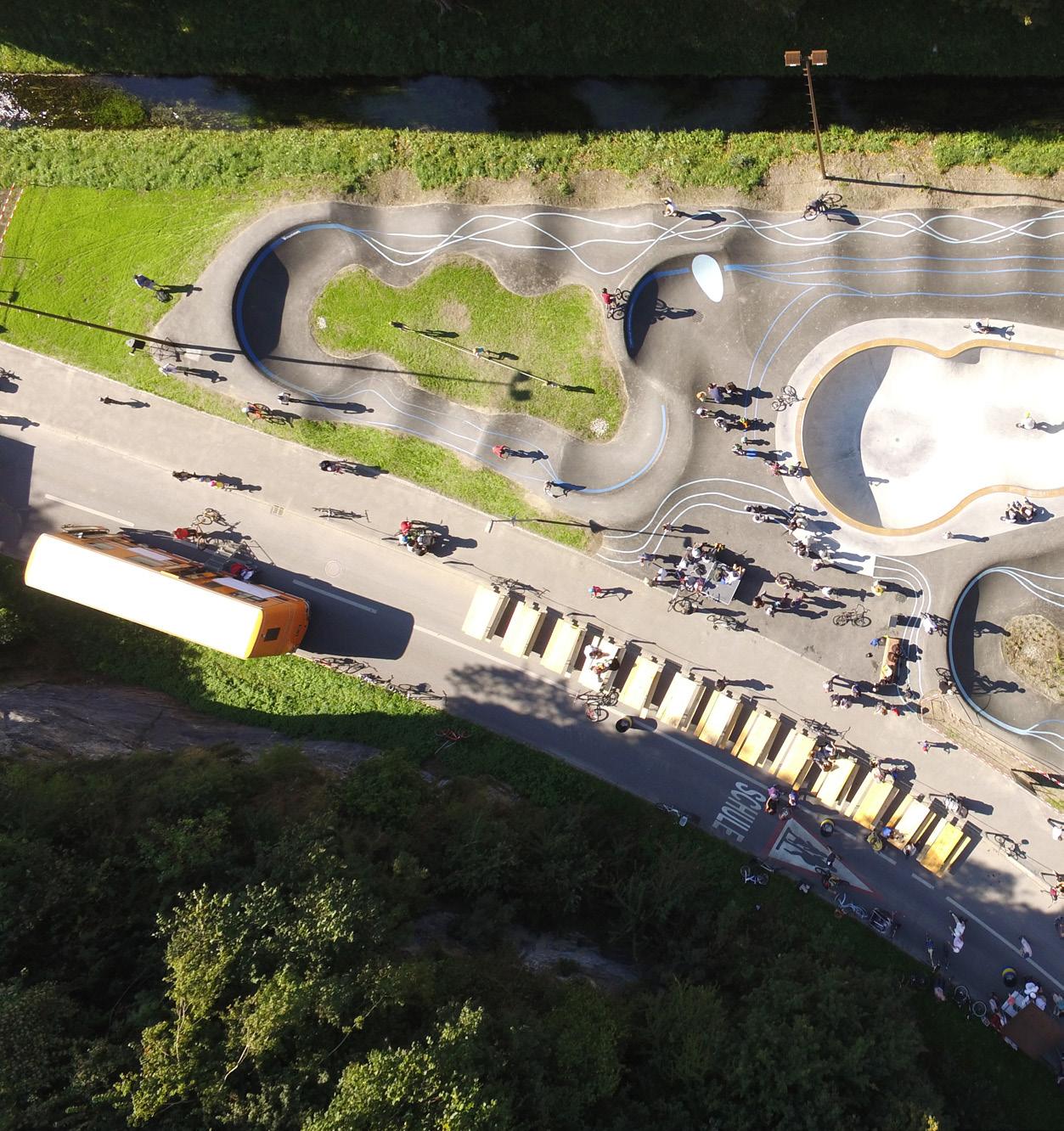
Here at Concrete Wave we have made it abundantly clear that we want to pave the world and put pumptracks everywhere. The best way to do this is to inspire you to ensure that the next skatepark in your town also includes a pumptrack.

The Velosolutions pumptrack at the foot of the medieval Gutenberg Castle is located right at the heart of the village of Balzers in the principality of Liechtenstein. The inclusion of a skate bowl at the pumptrack brings together two sports and with it two cultures. The facility has been cleverly designed to blend in with its surrounding landscape, enabling it to sit comfortably in its sensitive location.This is a truly unique infrastructure at a very special place.

In our Spring, 2017 issue we featured this park as it was nearing completion. As you can see, the has been asphalt seamlessly fused with the concrete along with the grass. This is the first skatepark/pumptrack hybrid in the USA and we strongly encourage all communities to build these kinds of structures. You really do get the best of both worlds.

The scenic, calm and laid-back area is adorned with Velosolutions asphalt pumptracks, and they confirm the phenomenon that has been observed worldwide. No matter how small the town is, the asphalt pumptracks are flooded by kids. They don’t want to stop riding and they don’t want to leave.

Grenchen is home to a full asphalt BMX training track with an Olympic-sized start tower and an asphalt pumptrack. The pumptracks includes jumps for beginners as well as a training area for sprint. The entire facility covers a surface of over 86,000 square feet. More than 54,000 square feet of gravel and 500 tons of asphalt were shaped up within eight weeks to become one of the biggest tracks of its kind. Since there was no access for trucks to drive the start tower to its place, it was flown in by a Super Puma helicopter.


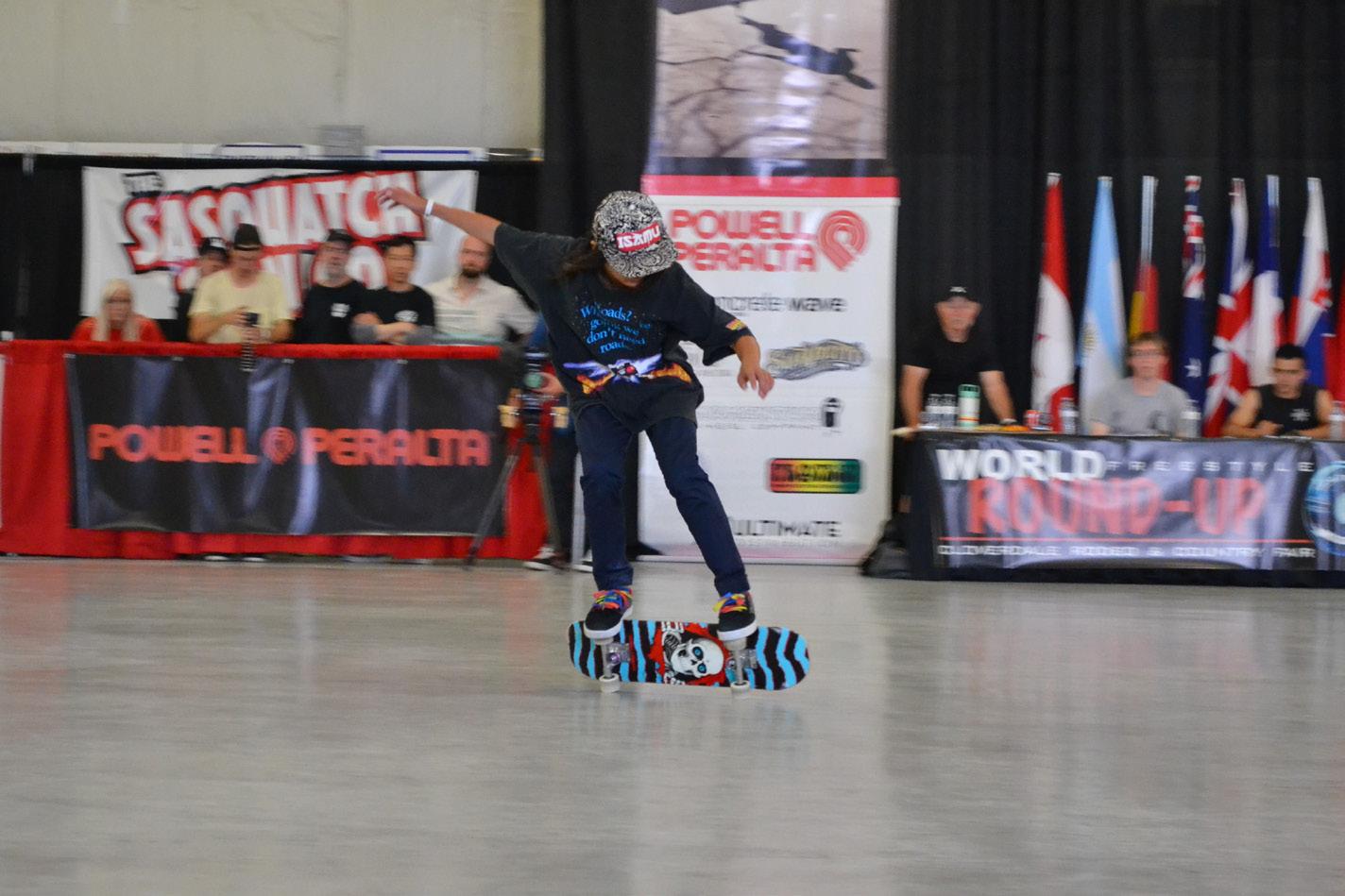 Photo: Tiffany Pereira
Photo: Tiffany Pereira


Editor’s note: We are very pleased to have legendary Z-Boy Wentzle Ruml IV on board as a contributor. This is the first of many reports from Wentzle.
In “Wentzle’s World,” I am focused on doing my part to help build my website wentzleruml.com, with the help of computer guru Dave Smith in Portugal. My vision centers around doing live video, interviews in the Islands, California, the East Coast, Colorado and other states, as well as Portugal and Europe – everything from surf and skate legends, pioneers and newer generations. I will be branching out to cover surf/skate photographers, shop owners, skatepark builders, musicians, artists, clothing designers and emerging graffiti artists with a variety of ideas skate/surf related. Hoping for this to be a “life changer” for me in terms of personal discretion in the latter portion of this life. Any and all support on this new venture is appreciated. Mahalo and Aloha from Maui.
The skate scene is alive and well on Maui. Lots of people of all ages are stoked on skating, which is awesome to see. There are new ditches being produced, some just too rough to skate without big soft wheels, if at all, and others that are really quite nice. New parks in the works or being rallied for, a few empty pools I’ve discovered and always lots of hills to be bombed, including Back Road to Hana’s fresh black tar runs with tons of runout. Big-wave surfer and friend David Langer’s pool in Haiku is being
utilized more with some free skate as well as organized events happening or in the works. Excited to be a part of that.

I first met Andrew in the latter part of 2009 when I moved to Maui full time. My very first connection in the skate scene here was Joshua Weisfeld, the one Maui contact that my manager, coach and friend Joe Iacovelli supplied me with. After I met Josh, he then took me around to meet people in the skate scene, and Andrew was one of the very first people I met. I knew in no time that he was ALL IN when it came to skateboarding. At first I almost thought he was “too nice,” but as he and I became friends and he invited me to join him and Davey Delong to be part of the Maui Skate Series, I knew it was genuine! Next to Joe I., who has been tagged as “the nicest guy in skateboarding,” Andrew is right there! It is an honor to have him as a friend.
Originally from Evergreen, Colorado, Andrew first got the skate bug in 1983, at which time there were no skateparks left in Colorado. Part of his stoke came from the “Full Bleed Issue” of TransWorld Skateboarding, in which Mark Gonzales and the ollie were featured. Andrew and crew started building various ramps and features, including lots of quarterpipes and halfpipes, to provide a place to unleash and progress in the sport. Labeled a “shop rat,” Andrew couldn’t stay away as he was drawn in by skate artwork and the creativity in these environs. He felt right at home. When traveling, Andrew would hit any and every skate shop in his path, and was also able to skate at the Del Mar Skate Ranch before its demise.
After graduating from high school, Andrew went to college in Boulder, Colorado, and also managed skate and snowboard shops through the early and mid-1990s. With his snowboarding
stoke, knowledge and accomplishments (1992 USSA Snowboard Champion) he was right at home. He would skate in the summer and hit the slopes in the winter. In the late ’90s, Andrew helped host demos at various skateparks that were finally re-emerging around the Denver area. After graduating from college, Andrew gave the corporate world a shot, working as a website builder and doing graphic design. After just two years he realized he was too boxed in, so he bailed and started a small Denver-based skate brand, appropriately called Denver Skateboards.

Andrew had started visiting Maui in the mid-’70s and continued to vacation at a family condo there for years. In the mid-’80s he knew where all the best ditches were on the island and skated them whenever he came here. The spark re-emerged after corporate burnout, and in 2001 he and his wife moved to Maui to live full time. After seeing the absence of, and need for, local skate products, he started a new brand, Aloha Skateboards, in 2002.
In addition to the new brand, Andrew saw a dire need for skateparks here on Maui. He immediately got involved in both plans for new parks as well as much-needed repairs at the semi-crumbling existing parks. But despite his compassion, commitment and vision, by 2007 only one of those five parks had survived the lack of maintenance, vandalism and seemingly uninterested and restless youth.
But Andrew didn’t give up. Working diligently with the Maui County Parks Department, in 2008 he and Davey Delong from Hi Tech started a new entity called the Maui Skate Series. The series thrived and conducted over 100 skateboard events. It provides skateboard events to kids in rural areas such as the islands of Lanai and Molokai and the rain forests of Hana. This led to the
creation of the Hana skatepark. The Maui Skate Series was alive and well from 2008 through 2012, when the County shut off funding.
In 2013 Andrew opened the Aloha Boards skate shop in Central Kihei, which he operated until 2015 when he moved into a higher traffic area closer to the beach. Today the shop is still very much alive and doing well.
The Maui Skateboard Series was reconsidered and approved in 2016 – largely, I believe, due to both Andrew and Davey’s commitment to the sport and ability to make things happen with little or no financial assistance.

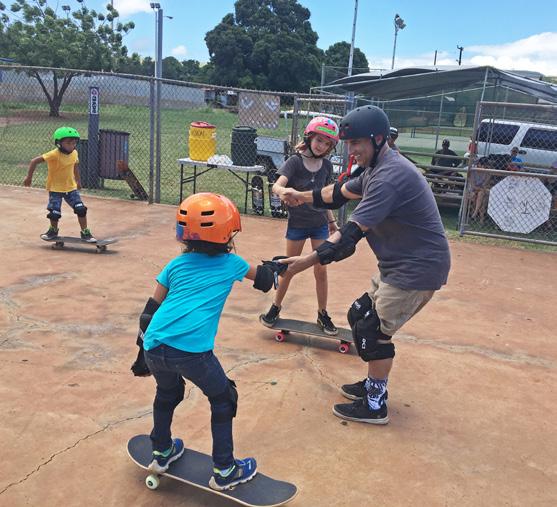

Andrew is very active in the community here in Kihei and spearheads for both skate-related causes and a long list of other community needs. He is the primary advocate for the $150 million Kihei High School, the first high school to be built in the state of Hawaii in 25 years, and designed the Kihei Bike Paths and Playground. He was also the primary advocate for construction of new Upcountry skatepark and the Kihei skatepark redesign. Construction of both will start this year.
Andrew happily lives a simple yet very busy life here with his wife and two kids. In addition to skate-related work Andrew enjoys time with family and friends. I’m honored to have Andrew as a close friend and to be invited once again to be part of the Maui Skate Series.
And the beat goes on … Aloha, WR IV

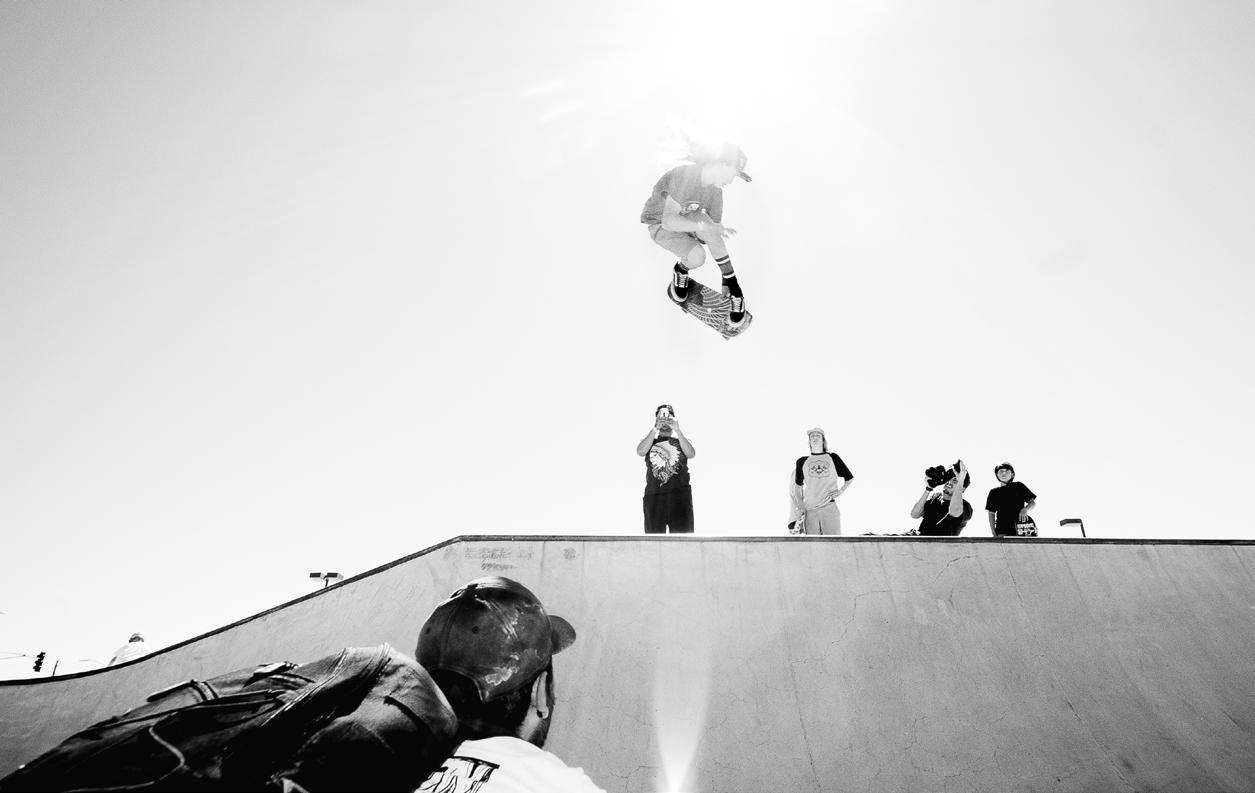 By Bud Stratford
By Bud Stratford
Phoenix SkaterCon is the brainchild of Adam Richards. Adam is not, by any means, an atypical skater. He’s a blue-collar working man, a husband, a collector, a bowl rider, a ditch skater, a fan –pretty much your average Joe, through and through. The only things that make him extraordinary are that he happens to be the ringleader of Phoenix’s “old guy skate club,” the Gray Beard Crew (which you can find on Facebook under “Prevent This Tragedy”), and that he happens to be slightly more motivated than the rest of us to dream up really big events, get his hands dusty, promote the hell out of his vision and make stuff happen.
This is the story of just one of his achievements.
TOP Liam Pace, backside melon tweak. Photo: Oliver Whitelaw BOTTOM JFA rocks the stage. Photo: Bud Stratford OPPOSITE PAGE TOP Legends group photo. Photo: Oliver Whitelaw OPPOSITE PAGE BOTTOM Dave Duncan signs a deck for a fan. Photo: Oliver WhitelawSkaterCon takes just a little bit of explaining, because there’s nothing quite like it anywhere, at least as far as I’ve seen. The basic idea is that it’s a “Comic-Con for skaters” – and that is, admittedly, a great point of departure. But SkaterCon is much more diverse. It’s part public trade show, part skate demo, part amateur contest, part party insanity, part jam session, part Q&A and part meet-and-greet. For the lucky reporter with press passes, it’s also a pretty convenient place to grab a quick story and get a little bit of miscellaneous “work” done.


When Adam plans “an event,” it’s not just your ho-hum, run-of-the-mill, one-day-and-done sort of affair. No, buddy! When Adam plans an event, it’s a weekend-long funfest that leaves you completely spent, utterly exhausted and totally sassified. My weekend started on Friday evening at Joe’s Grotto, a watering hole and music venue on Phoenix’s northeast side. This “Kickoff Party” to the weekend’s festivities started around 7 p.m. and lasted until well after midnight, way past my conservative bedtime regimen these days.
There were four really, really loud bands that played the Kickoff: The Bathless Bastards, the Earlygrabs, Dephinger and the Father Figures. The Earlygrabs and the Father Figures are both fan favorites that ripped fast, punk-infused sets. The Father Figures feature Cornelius from JFA, which gives them instant-locallegend credibility, and a depth and breadth of musical influences, while the Earlygrabs stuck with what I might call classic skate thrash. But the big surprise of the night was the Bathless Bastards from Texas, who struck me as being a bit grubbier and a much more metal version of Motörhead, if you can imagine such a wondrous thing.
Unfortunately, I missed the entirety of Dephinger’s set because I was pretty busy working the room. Because of Phoenix’s close proximity to Southern California – Los Angeles is, after all, a mere six-hour drive away – SkaterCon attracts a lot of living legends and luminaries. This year’s list included Eric Dressen, Rick “Spidey” De Montrond, Marty “Jinx” Jimenez, Jim Jam Gray, Dave Duncan, Steve Steadham and
Jesse Martinez, along with SkaterCon alum Chuck Treece, Dave Bergthold, Steve Alba, Billy Ruff, Patti McGee, Bill Danforth, MoFo and collecting connoisseur Daymond Dodge. The big surprise of the weekend was Jonas Wray, who was on hand to promote Wray Bros, the brand that he co-helms with his brother Jeremy. Almost all of them stopped in to take in a set or two at the Grotto. So, sorry Dephinger. I’ll try to catch ya next time.
This years’ SkaterCon was held at Paradise Valley Skatepark, one of Phoenix’s many concrete outdoor oases. The public trade show area was across the driveway from the skatepark in an expansive parking lot that could easily accommodate up to 30 vendor tents, plus the main music stage, all in one easy-to-browse spot. The best part about the venue was that you could hear the music from the main stage, quite clearly, almost anywhere on the premises; the acoustics were simply amazing.


One of the unintended advantages to this easy-breezy modus operandi is that the attendees can not only get their grubby hands on the latest and greatest people and products, they can also go right over to the skatepark and try them out for themselves. Almost as soon as I waltzed into the venue, I was standing on a Hosoi downhill prototype that Jesse Martinez was rocking, discussing the finer points of concave concepts. I also got to take a roll on those new Avenue suspension trucks, which worked far better than I might have originally imagined. I then spent the better part of my Saturday tooling around with Mike Kitchen, and sampling the entirety of Millennium’s new deck lineup. Really, all skateboarding trade shows should be set up like this, i.e., a giant public product demo party. After experiencing SkaterCon for myself, I’m really sort of surprised that they aren’t. Agenda actually starts to look a little bit stale and starched, when mentally compared to this vibrant and vivacious rule- and ground-breaking newcomer.
There were what seemed like a zillion small companies in attendance at SkaterCon. I almost forgot to mention that part. Every time I turned around, I was being confronted by yet another small startup newcomer to the marketplace, while the “Bigger Brands”
were conspicuously and notably absent. It struck me immediately as a bit of a missed opportunity for them to solidify their standing, and left a gaping hole for the smaller, smarter and nimbler newcomers to wade through, much to their obvious advantage.
The biggest “brand” on hand this weekend was probably Steve Steadham. When his bus rolls into town, everybody takes notice; it’s definitely an impressive example of eye-catching hugeness. Parking it showside takes a lot of determined skill and patience, so much so that I assumed that Steve had a professional driver at the helm of his personal ark. When I discovered that Steve actually drives his own bus, I was completely bowled over by his chops. That man has talent!

Steadham is not only a seriously skilled mega-bus driver, a talented skateboarder and an entire industry unto himself, the guy can rock a reggae set like you wouldn’t believe. The one thing that he is not particularly attentive at, however, is being a sales rep for Steadham Industries. At some point on Saturday, I swung by to check out his ambitious new shoe lines. That’s “lines,” plural, because he is an avid entrepreneur par excellence. He kindly asked me to look after his tent “for a few minutes” while he ran a quick errand. Thirty minutes later, I’m really starting to worry, asking myself, where did this guy take off to, and is he all right? That’s when Travis (from Millennium) points out that Steadham’s on stage, cutting himself a reggae rug. You’ve gotta be kidding me, right? So I leave Travis in charge of Steadham Incorporated for a few minutes, and saunter straight to the stage to check this all out for myself. Sure enough, there he is, manning four different keyboards and crooning away while Chuck Treece is laying down subtle licks on his guitar. And he sounds really, really good up there. Is there anything this guy can’t do, and do well? He’s nothing less than a one-man everything!
Somewhere along the line, there was a bowl contest that I completely missed out on. There was simply too much stuff to do, see and experience; there was no simply way in heck you could ever take it all in within one puny little weekend.
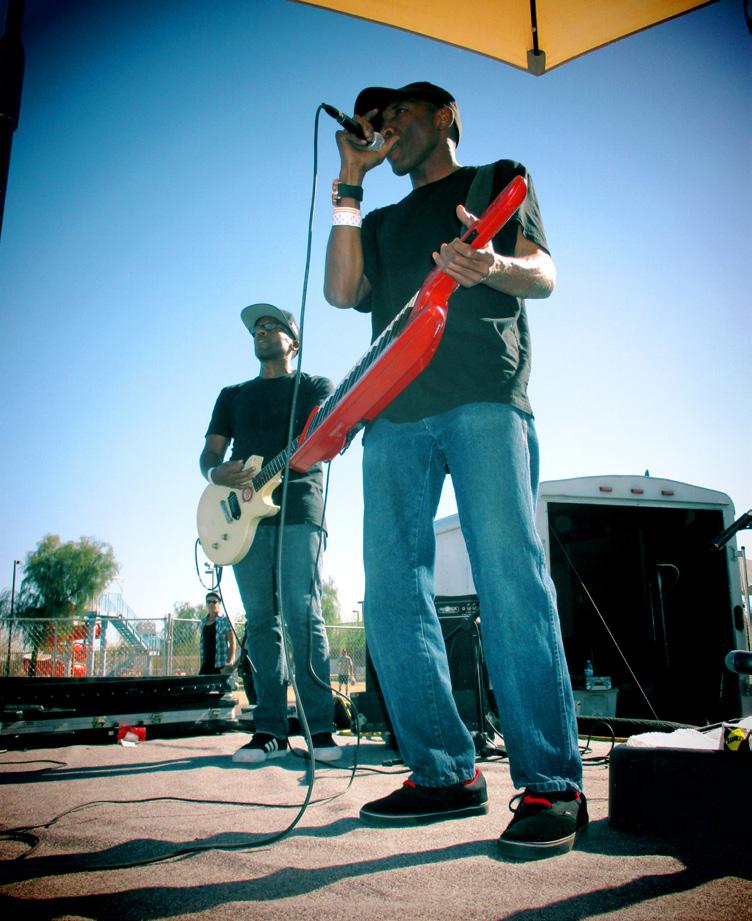 OPPOSITE PAGE TOP “The Time Traveler,” classic layback.
Photo: Bud Stratford
OPPOSITE PAGE BOTTOM Girls bowl contest winners.
Photo: Oliver Whitelaw.
ABOVE
Steve Steadham and Chuck Treece laying down reggae licks.
Photo: Bud Stratford RIGHT
Steve Steadham’s mega-bus.
Photo: Bud Stratford
OPPOSITE PAGE TOP “The Time Traveler,” classic layback.
Photo: Bud Stratford
OPPOSITE PAGE BOTTOM Girls bowl contest winners.
Photo: Oliver Whitelaw.
ABOVE
Steve Steadham and Chuck Treece laying down reggae licks.
Photo: Bud Stratford RIGHT
Steve Steadham’s mega-bus.
Photo: Bud Stratford
JFA was Saturday’s headliner band. They were the band I was most excited to experience. After all, I’ve been skating for well over 30 years now, yet I’ve never seen JFA live. So this was a perfect opportunity to put that travesty to bed and kick another must-do off my personal bucket list. During their set, they instigated one of the best things I saw all weekend: a skateboarding circle pit that included kids of all ages, boys and girls, right alongside old guys and geezers, rolling around in symbiotic harmony. Everyone was in there, and everyone was having the time of their lives to the soundtrack of one of the alltime best skate rock bands ever.

Saturday night was the local premiere of Made in Venice, the Jesse Martinez documentary. Once again, Adam left no hour unscheduled; there was something going on, somewhere, all weekend long. The premiere was held at a local theater, naturally enough, and quite a few of the day’s attendees made it to the evening event as well. The movie largely picked up where Dogtown and Z-Boys left off, and chronicled Venice’s skate history between the late 1970s through the current era, including the locals’ extremely tenacious efforts (to put it mildly) to get a free, public concrete skatepark in Venice, and to maintain it in the face of constant attacks from extremely energetic vandals.
Sunday was a bit more mellow and laid back, probably because Saturday had been so hectic and busy that everybody (myself included) was simply exhausted from the previous day. That didn’t stop the street kids from seizing a jump ramp from the Gator Skins guys and tossing up an impromptu (and epic) launch-ramp session. Chris Roberts won the trick of the day straight away with a benihana varial, while Mike Kitchen won the “dedication award” for repeatedly tossing his bulk high into the air and piloting strong-armed methods with his 44-year-old frame. I’m glad I was merely there to document the day, because my knees were aching painfully enough just watching him stomp those solid landings.
“The Time Traveler” was the handsdown hit of the weekend. Nobody seemed to know his real name; he was wrapped in a shroud of mystery and mystique, which was magnified because unlike most skaters, you couldn’t get


him to talk very much (if at all), even if you tried your damnedest (which I most definitely did). He couldn’t have been a day over 16 years old, if that, but he had a pretty close to period-correct Powell-Peralta Vato Rat deck (outfitted with Aces and G-Bones), accentuated by a complementary, period-correct outfit, complete with baby blue Vans Highs, bold red-and-yellow Rectors and a fullcoverage Pro-tec. He carved the bowls with intense speed and concentration and a rubbery style reminiscent of Rick Blackhart, while busting spontaneous laybacks that would have made Duane pretty damned proud. The Time Traveler was an extremely modest fellow, but that still didn’t stop him from being the subject of the better part of the weekend’s bubbling banter
The very last band to play on Sunday was the Ziggens, the perfect band to button up the weekend’s wonders. The Ziggens are not really a “punk” band at all, much to my eardrums’ delight, but rather a ’60s-inspired surf-’n’-drag sensation that sounded like a cross between the Challengers and the Cramps. They knew how to have a good time, that’s for sure. The crowd sat squarely on the fine line between “WTF?” and “Holy wow, that’s f’n awesome!”, which created a fun and playful dynamic that only seemed to feed the band’s already raucous set of feel-good, fuzzy reverb rockers.
There are probably more than enough “thanks” that could (and should) be floated around, including toward Adam himself; his extremely supportive wife, Sandy; the staff of excellent volunteers, who were extremely adept at making sure everyone was having a grand time; all the brands that bought booths; all the bands that rocked the house down; the living legends and luminaries that gave us all a reason to fully fan out; the city of Phoenix for allowing us all to have a bit of fun; and of course the skaters who kept it all lively and luscious.
But personally speaking, I think the attendees that bought and paid for the tickets might be the biggest heroes of them all. Without real and tangible financial support from the skateboarding community, these sorts of groundbreaking events would be unsustainable. So thanks for coming, everyone! I hope you had as much fun as I did! See all y’all next year.

 OPPOSITE PAGE TOP
Stylish stalefish, you’ll have to ask Oliver who that is.
Photo: Oliver Whitelaw
OPPOSITE PAGE MIDDLE
Under 14 bowl contest winners.
Photo: Oliver Whitelaw
OPPOSITE PAGE BOTTOM Brian Brannon of JFA.
Photo: Jason Cook
ABOVE
Chris Roberts, benihana to varial. Yes, I’m totally serious.
Photo: Bud Stratford
OPPOSITE PAGE TOP
Stylish stalefish, you’ll have to ask Oliver who that is.
Photo: Oliver Whitelaw
OPPOSITE PAGE MIDDLE
Under 14 bowl contest winners.
Photo: Oliver Whitelaw
OPPOSITE PAGE BOTTOM Brian Brannon of JFA.
Photo: Jason Cook
ABOVE
Chris Roberts, benihana to varial. Yes, I’m totally serious.
Photo: Bud Stratford
I am 26 years old and live in Ontario. I first got into longboarding back in 2009, a few months before my 19th birthday. When I was 17, during my final high school year, I was heavily addicted to multiple hard drugs. I had been labeled by some as a junkie, and I found it hard to disagree with that (if I was being honest with myself). I had moved out of my parents’ home in early 2008 and continued to spiral downward out of control in the months following.

Just before my 18th birthday, I hit my rock bottom. I’d had enough: enough of the drugs, the lifestyle, the pain, the sickness, the loneliness, the weakness. I dropped everything cold turkey, spending months and months getting over my addiction, the withdrawals, the panic attacks, the malnourishment. I was trying to figure me out – the unfiltered version, the side of me that was sober, the real me. It wasn’t until summer of 2009 that I really felt more myself than ever before.
I was living with a family at the time, and their house was right at the base of a hill. I happened to be out at the end of the driveway one day and I noticed two riders on longboards

coming down toward me. I was mesmerized, staring in awe as I watched them bomb the hill. As they got close to me, I locked eyes with one of the riders and realized I knew him.
At the bottom of the hill, both riders slid to a stop and came over to say hello. One of them I didn’t know well, but the other one was a guy I knew through my brother.
I don’t think I even said hello; I just went on about how what they were doing was the coolest thing I had ever seen, how I wished I could do that. I had never actually hung out with this fella, but I still flat-out asked, “Can you teach me how to longboard?” With a big smile, he said he could definitely teach me.
I had never been able to balance on a skateboard, a snowboard or a longboard, but the next week we got together and slowly started working on my balance. I started with going straight, learning to push, and developing a most important skill – the footbrake. I was terrible on a board, both with balance and confidence. But I wanted to skate, so I kept at it.
A week after some beginner lessons, I wanted to try to go out on my own. I got a board to borrow, and I hiked myself to the top of the same hill that I’d first seen the guys flying down. As I walked up from the bottom, my heart raced. I had barely done even mellow slopes, let alone ridden a hill. I had no equipment to ride with, either: no helmet, gloves, knee or elbow pads. I stood at the top, feeling a rush like you do when you are at the peak of a roller coaster. In my head I kept calling myself a wuss, saying to myself that I’ll always be afraid if I never try.
With the unfortunate help of those thoughts, I pushed off. I made the first corner (surprisingly), almost immediately got speed wobbles (not surprisingly), and then pancaked so hard I scraped up my entire body – including my face, which was one of the first things to hit the pavement – leaving me concussed and giving myself the only black eye I have ever had. How weird that my lack of safety equipment and choice of clothing (little shorts and a tank top) didn’t hold any protection for me – NOT! Let’s just say I learned a lot about limits and safety equipment that day.
Two weeks later, when I could finally walk properly again, I went and bought my very first complete longboard, a Landyachtz Drop Speed. I was ecstatic. My balance was still terrible and I now had a fear of falling to conquer, but I just kept at it. Every day I rode my board anywhere and everywhere.
There was something about longboarding that drew me into it completely and fully. I had a passion for it like I’d never had for anything before, ever. It was total zen. It was a place to escape. It was freedom. It was this amazing feeling, something indescribable. It was in this that I found peace with myself. It put me on such a high, and for the first time, it was a high I did not need to feel ashamed of. For me, it somewhat replaced that euphoric place that drugs had in my life. It gave me an outlet. It gave my brain a place to run away to. It didn’t matter what
I was upset about or mad at; if I went longboarding, I would come home feeling amazing. There was and is so much focus on your body, board, and the road beneath you, that it is near impossible to think outside of that while you ride. The sound of urethane on pavement becomes something so soothing, so relaxing. Nowadays I literally dream of longboarding.
I wanted to share my story so I can tell people that longboarding is more than a sport. Longboarding is a feeling, a passion. It can be whatever you need it to be: your medicine, your need for speed, your escape, your way of expression, your reason to exercise, the rush you’ve been craving, etc. It can
give you that zero-to-hero feeling. It can make your troubles appear smaller. Longboarding is simply amazing, and the longboarding community is one of the most inclusive I have ever seen.
I would tell anyone thinking that they would like to longboard to go out and try it. It’s going to take practice and determination, but know that everyone started somewhere. Don’t get discouraged by your lack of balance or your first fall. You will improve and gain confidence over time. Get back up and keep at it. Keep doing what you love and what makes you happy. Keep longboarding.

“It gave me an outlet. It gave my brain a place to run away to. It didn’t matter what I was upset about or mad at; if I went longboarding, I would come home feeling amazing.” “
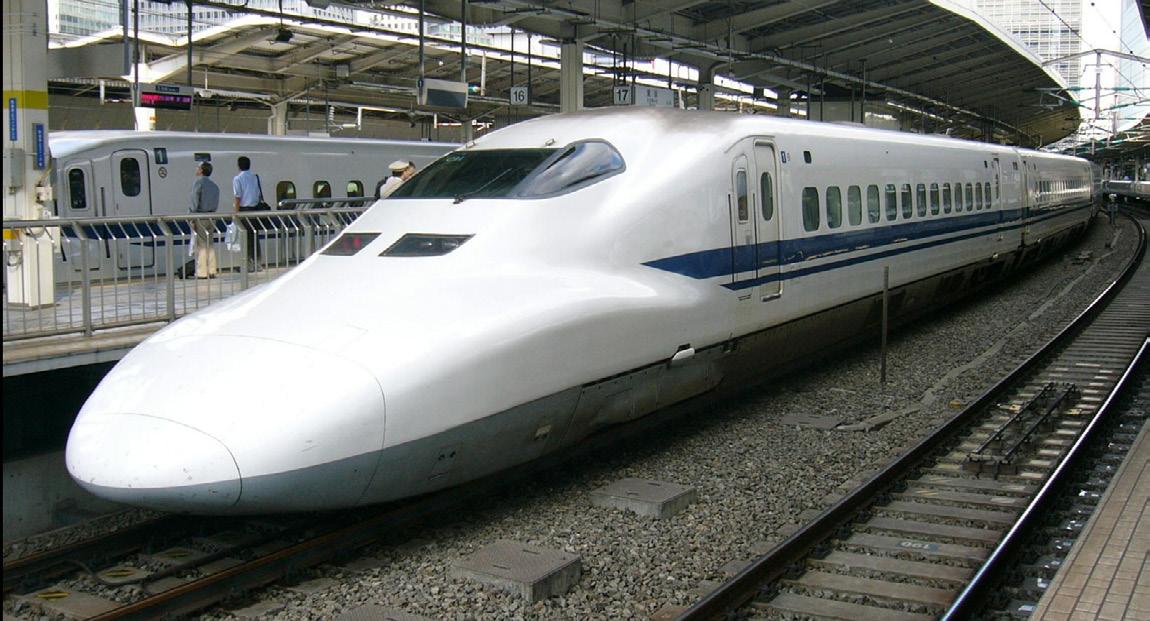 By Daniel Trujillo
By Daniel Trujillo
First thing to do after procuring transportation to Japan is to obtain transportation around Japan, in the form of a Japan Rail Pass. The Japanese train system is phenomenal and incredibly efficient. Also, riding the Shinkansen (bullet train) made it absolutely painless to travel long distance – infinitely more comfortable than a plane ride, in fact. On top of comfort, watching the world pass by at 200-plus mph just above the ground is really cool, if kind of nauseating.
The 7-Elevens in Japan have everything a skater needs to survive: musubi, beer, squid jerky, Ultraman magazines, an
Being a “Western” skateboarder, and going to a distinctively foreign country, alone, on a minuscule budget, with no plan of where to stay or even what you are doing, coupled with a near inability to speak the language … all of that might seem like a recipe for disaster. But that’s precisely what I did when I attended the All Japan Freestyle Contest and the Road to the King contest in Koshigaya Lake-Town, Japan. The following is how I survived the Land of the Rising Sun as an ill-prepared freestyle skateboarder.
area to consume it all, and free Wi-Fi! The food was grade A in my book, and so inexpensive that I barely had to dip into the reserves of Soylent I brought just in case I ran out of money for food.
Housing was more difficult to figure out. Usually when I go somewhere to skate, I know a local skater and can sleep on their floor/couch/refrigerator, etc. However, even though I know about 30 skaters in Japan, they all have very limited space. So I ended up lodging in Shin Yokohama for part of my trip at a very nice, modestly sized (tiny) hostel for ~$120 for a week. I
also spent several days in capsule hotels – small tubes just large enough to encapsulate a one-person bed.

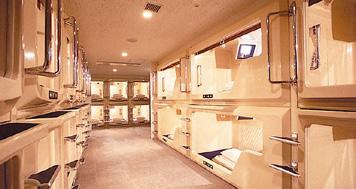
I absolutely loved the capsule hotels. First, they were a very different experience than my usual sleeping arrangement, and second, they were super cheap. Shin Yokohama also has a really good skatepark, where a lot of extremely good skaters go to shred.
Skating seemed so widely accepted that I saw infants, centenarians and every age group in between doing it. I even saw skateboarding dogs and a skateboarding cat. Nobody seemed to take skating even a fraction as “seriously” as Western skaters, but many seemed just as dedicated, if not more so. Fun appeared to be the focus of a skate session, as opposed to filming or landing a trick. Nobody seemed excluded from sessions, either. Whether beginner or legend, everyone was welcome to come “play skateboards,” as I heard it called.
My Shinkansen experience was from Tokyo to Osaka to visit the Osaka Daggers at Triangle Park – a must for any “creative” skate tourist. The Daggers are legendary in Japan, from what I can tell, and they were legends in my mind before I’d even been to Japan.
I showed up to Osaka’s Whatever skate shop late at night. Despite never having met any of the Daggers before, we spent hours skating at Triangle, learning tricks from each other and trying to make up new ones, all while trying to convince the cops that “we’re not skating, we’re drinking.” Though skating is accepted in many other places, Triangle Park is hilariously part of a police station plaza, directly across from a skate shop. Yes, one of the most iconic skate spots in Japan is at a police station, where skating is not allowed, but drinking is.

There are many incredible skateboarders in Japan, possibly the largest population of exceptional skaters I’ve ever seen. Among them are legends whose names have barely trickled over to the Americas. From the ’70s we had Aki Akiyama, the first pro skater in Japan. From the ’80s there was Moichi Suzuki, and the legendary Fujii brothers, Masahiro and Toshiaki. Modern legends include the young up-and-comers Ikkei and Toki, the wizard of footwork Takashi Suzuki, and dozens of females including Mic Murayama and Mirei Tsuchida.
So, despite my seemingly disastrous plan, my trip to Japan was amazing. Not only did I not die, I had the honor of skating with many people who are living legends in my mind. None of them showed any sign of the arrogance or inflated ego I’ve seen displayed by many Western skaters. When I returned to my home in Las Vegas, it was with a more enthusiastic and fun approach to skateboarding.
Pick up your trash, stay humble.
My decision to live in Japan started with my love of the language. I have studied Japanese since I was 13 years old. Vancouver has a large population of Japanese speakers, so as soon as I learned new grammar or vocabulary in the classroom, I had plenty of chances to try it out. In high school I would hang out in downtown Vancouver almost every day, so I was speaking Japanese before I even went to live in the country.
I wanted to study even more, however, and get the highest level on the Japanese-Language Proficiency Test, so I saved my money from my part-time job and skateboard demos until I had enough to attend a language college for a year. From there my obsession with the language grew, and before I knew it I reached a point where I read more books in Japanese than in English, which is where I started to develop a huge passion for reading and learning.
After my year at the language college, I went back to Canada for a half a year
to save money so I could go back to Japan on a working holiday visa and learn more. For that bit of money I saved up, I got another year in Japan, packed with life-changing experiences. I made tons of new friends, worked at a home-electronics store and a Japanese language school for foreigners (JSL), did some translating and interpreting work, modeling and skate demos – and on top of that I married my beautiful and amazing wife, Rachel.
Freestyle skateboarding is one of those things that it’s very hard to find someone doing. True, almost every country has at least a couple of practitioners quietly pursuing their passion. But if you dig deeper, you will find a few countries in particular seem to have a thriving scene.
One such country is Japan. I spent a few years living and skating in the country, and during that time I learned a lot about the skate scene in Japan and how differently they view skateboarding compared to how we view it in the
West. I think this unique perspective has played a huge factor in the prosperity of Japan’s freestyle skateboarding community.
“You skate like Rodney Mullen!” is something everyone who practices this discipline of skateboarding hears, largely because Rodney is the only freestyle skateboarder most people know of. What I love about Japan, though, is that I’d rarely get comments like that there. Mostly I’d hear things like, “How long have you been practicing freestyle?”
“Are there many freestyle skateboarders in Canada?” or “I didn’t know freestyle skaters could ollie that high!
”Of course street and vert are what the majority of people ride in Japan, but what’s great about the Japanese scene is that you can usually find at least one freestyle skateboarder on a busy day at the skatepark. From the average skater’s point of view, freestyle is part of their scene. We actually exist! I think a large part of this has to do with the open-
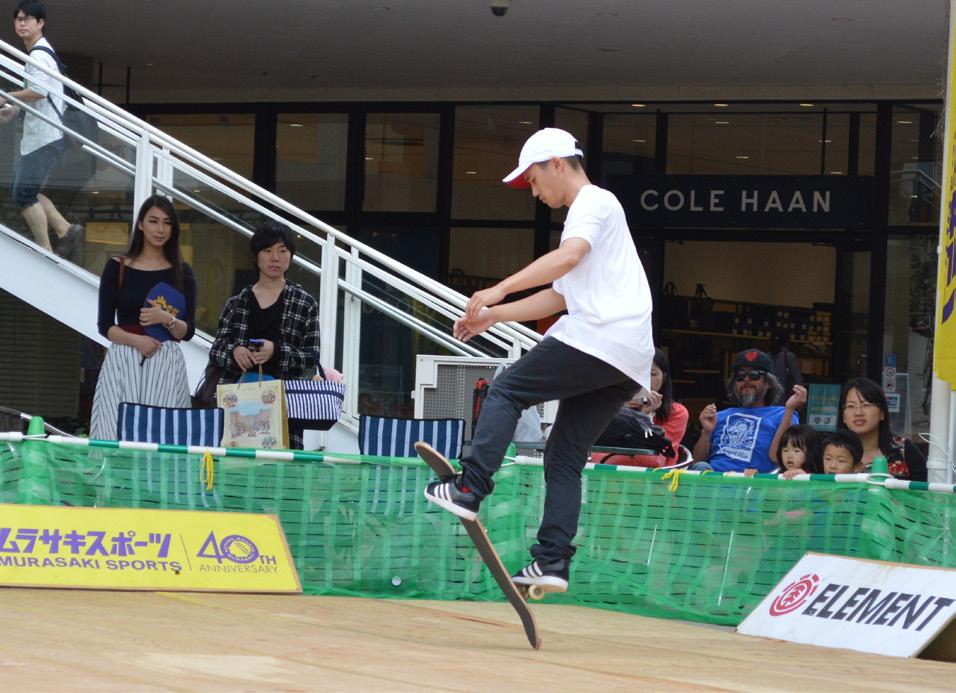 LEFT Tomo Koyano
OPPOSITE TOP LEFT Ikkei Nagao
OPPOSITE TOP RIGHT Toshiaki Fujii
OPPOSITE BOTTOM LEFT (left to right) Mizuki Miramatsu, Kotori Ishida, Hina Yamawaki
OPPOSITE BOTTOM RIGHT (left to right) Sora Yamawaki, Mirei Tsuchida, Hina Yamawaki
LEFT Tomo Koyano
OPPOSITE TOP LEFT Ikkei Nagao
OPPOSITE TOP RIGHT Toshiaki Fujii
OPPOSITE BOTTOM LEFT (left to right) Mizuki Miramatsu, Kotori Ishida, Hina Yamawaki
OPPOSITE BOTTOM RIGHT (left to right) Sora Yamawaki, Mirei Tsuchida, Hina Yamawaki
mindedness that so many skaters have in Japan. Everyone skates everything, and I’ve found that people just aren’t concerned as to which tricks are considered cool or not.


No matter how good a skateboarder you are in Japan, it is next to impossible to find a sponsorship that will pay you enough to pay the bills. Japan has its own professionals, but even they have day jobs. In a weird way, though, this may help foster the creativity that a lot of Japanese skateboarders possess. There isn’t as much pressure to conform and do tricks that a company wants you to do. Whether you’re doing a certain trick or skating a certain style that is “in” or not, no company there is going to be paying your bills, so you might as well skate in a way that feels natural and fun for yourself.
While I was in Japan, I got to know the freestyle community on a much more personal level, and a huge thing I noticed is how active everyone is. People are
constantly getting together to skate every week with the same crew, regardless of age, and they are always recording. If you look at the JFSA YouTube page run by Masahiro Fuji and Toshiaki Fuji, you will find tons of videos of contests and videos of a variety of freestylers, as well as rider interviews.
The icing on the cake, though, is all the contests and demos done in Japan. Every year there are at least two or three freestyle contests across the country, each one attracting a good number of talented competitors. One big reason is the size of the country and the transit system. On Honshu (largest of the four main islands of Japan, which includes major cities such as Tokyo and Osaka), a middle school student could get to any major city by train on their own without a problem. The bullet train makes this especially possible, allowing people to skip the hassle of taking a plane, but getting them there in about the same time. This accessibility is a key factor in fostering such a large community, since
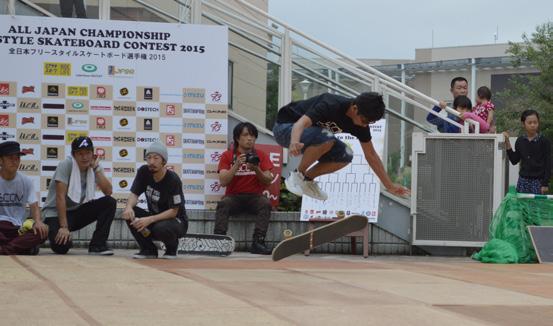
all the pros will generally see each other at least once or twice throughout the year.
With all these factors involved with the freestyle community, as well as the Japanese skateboard community in general, it’s became more and more apparent to me how much more accessible and easy it is to get into freestyle in Japan. In North America, if you decide to practice freestyle, you’re very likely to be on your own, and going to a contest just to meet other freestylers ends up being a rare thing. Of course there is a great online community that connects us; however, as far as personal interaction with other freestylers goes, it’s definitely not something we get to do as often, so it’s hard for someone just getting into it to get motivated and stay motivated. I’d like to thank all the Japanese skaters I’ve met and congratulate them for creating and nurturing such a vibrant scene. Based on my experience there, freestyle in Japan is in very good hands.

 By Michael Brooke
By Michael Brooke
Skateboarding is not the first thing you think of when you think about Jamaica. But rest assured, there is indeed a Jamaican skate scene, and the opportunities are endless on this tropical island. For most visitors, the beaches of Ocho Rios or Montego Bay are their primary Jamaican experience. Some guests, if they defy the management of the hotel, venture off
the property and experience another side of Jamaica. For many years I have been waiting for the right moment to visit Jamaica. I was not really interested in an all-inclusive resort – I wanted a taste of the real Jamaica. Fortunately, through a set of wonderful circumstances, I found myself in Jamaica at the right time and with the right people.
The genesis of the trip begins in November of last year when Luis Bustamante (of Bombora Boards and ZF Bolts fame) visited my house. I had posted about my sale of skate collectibles, and Luis showed up ready to make a deal. While we had known each other fairly well, this visit seemed to bring our friendship to another level. I loaded Luis up with a large number of items and worried if he would have the space in his apartment. I needn’t have worried. Turns out Luis is a master of space conservation and now oversees the CW archives.
Over the course of several weeks, our conversation drifted to a potential trip to Jamaica. One of Bombora’s pro riders, Brady Brown, is a transplanted Jamaican, whom I had seen a number of years ago tearing things up at Toronto’s infamous “Poop Chute.” As things started to come

together, the beginning of April seemed like the perfect time to book a flight to Kingston, and that is precisely what we did.
Brady’s family still lives in Jamaica, and his father, Herschel, is the councilor for Chapleton in the parish of Clarendon. Clarendon is in the center of Jamaica, about 70 minutes or so from Kingston. It is surrounded by lush green mountains and is absolutely a magical place.
Our flights booked, I contacted “Jungle” Jim Kuiack (our international man of mystery here at CW), who suggested that I contact Lance-O of Kulcha Shok Muzik. I’ve known Lance for a number of years, and Jim said he would have some good contacts in Jamaica. Turns out Jim was right. Lance suggested that I contact the folks at Jamnesia, a great surf camp just 15 minutes away from the Kingston
BELOW Brady Brown takes to the freshly paved hills of Chapleton. Photo: Michael Brookeairport. I contacted Jamnesia’s owners, the Wilmot family, and explained that I was coming to Jamaica and wanted to do a skate workshop for the locals.



Adding to this Jamaica connection, when I was in Munich at the ISPO trade show in February, I met up with Dennis Telfer, one of the founders of Sector 9. Pointing to a Bob Marley longboard, I asked Dennis if he knew anyone who worked with the brand. Turns out he did, and I began to exchange emails with Alicia Williams of the Bob Marley Foundation. I explained that I wanted to bring Longboarding for Peace to Jamaica, and Alicia set about making things happen at Tuff Gong, the famous recording studio where Marley created his musical masterpieces.
The final piece of the puzzle came when I happened to mention on a Facebook post that I was looking for local contacts in Jamaica. A man by the name of Steve Douglas emailed me and said he was
owner of Jamaica’s first skate shop –Skateboard Palace.

Our four-hour flight was free of any hiccups, and soon Luis, Brady and I found ourselves in 80-degree-plus heat. Brady’s father met us at the airport with a welcoming smile and we quickly headed out to Jamnesia.
Jamnesia is located in Bull Bay, where Bob Marley used to run on the beach. A few years ago, Jamnesia built a concrete bowl. It’s very tight, but a great deal of fun. The vibe at Jamnesia is very cool. Managing Director Imani Wilmot made us feel so welcome. About half a dozen
FAR LEFT
Enjoying the Gibbon Slackline at Tuff Gong Studios.
Photo: Luis Bustamante
NEAR LEFT
The locals took to skateboarding extremely quickly.

Photo: Michael Brooke
BELOW LEFT Steve Douglas (left), owner of Skateboard Palace, with some of his skate team.
RIGHT Brady Brown carves the Jamnesia Surf Camp bowl, currently the only one in Jamaica.
BELOW
Longboarding for Peace was very proud to work with the Marley Foundation.
kids, ranging from 18 months to 8 years of age, enjoyed the balance boards and magic tricks. Most of the children were in water before they could walk, and displayed incredible balance. As the adults looked on with smiles, I realized that our trip could not have started any better.
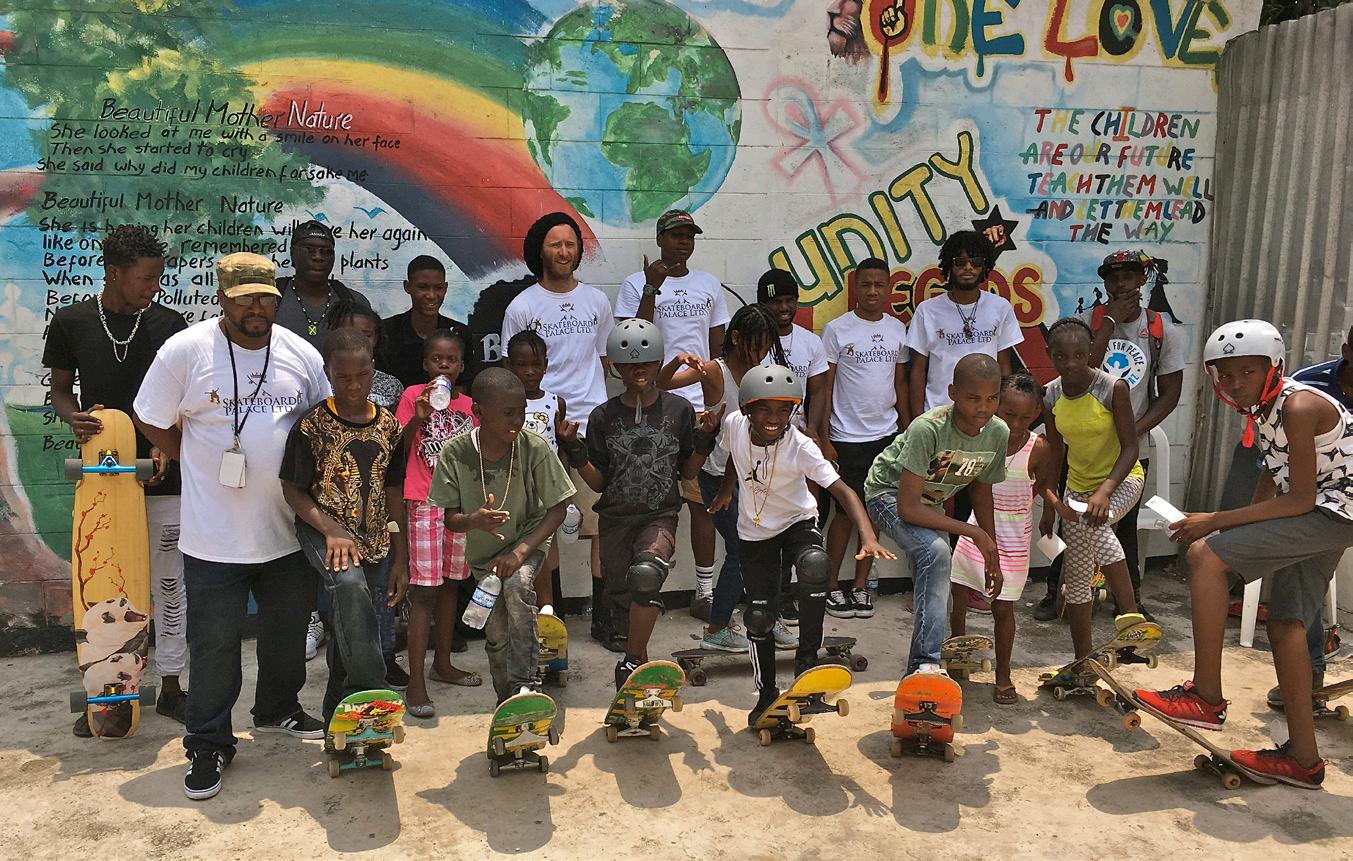
A few hours later we departed for Chapleton. First we took one of the new toll highways that have made getting around Jamaica much easier. After about 40 minutes, however, we veered off the highway and onto the local roads, and here I began to understand the roots of Brady’s skill as a downhill skater. The roads are tight and winding, and everyone seems like they are in a hurry. It’s one part exhilaration mixed with two parts controlled chaos. As Brady would remind me on numerous occasions, “It’s about driving appropriately.”
As we ventured closer to our home for the week, we were excited to see fresh asphalt was being laid throughout the parish. Again, I thought “What an incredibly good omen!” We stopped
in Maypen (the closest larger town to Chapleton) to pick up some Kentucky Fried Chicken. Believe it or not, KFC in Jamaica is somewhat different than its North American counterpart. It seems tastier and less greasy. Apparently, KFC use Jamaican-raised chickens. As we took in the incredible views from Brady’s home, everyone agreed that it was a perfect way to end our first evening.
If you’ve ever visited an island, you’re sure to come across the expression “island time.” The intense pace of Toronto and sense of urgency that seems to envelop my day-to-day existence simply washed away in Jamaica. I woke up early on my first full day in Clarendon to watch the sunrise. It was an unforgettable moment.
Luis put his culinary skills to the test and rustled up a fresh breakfast. Our appetites satiated, we headed into town to explore. It was here that we met up with a gentleman named Ralston. Ralston was almost like family to Brady. As a schoolboy, Brady was dutifully brought
home from Clarendon College by Ralston each day.
Throughout Jamaica you will find all kinds of patties (a pastry that contains various fillings inside a flaky shell), but the three of us fell in love with Juici Patties. It’s a very successful chain, and it got its start in Clarendon. We visited numerous times. But don’t just try the patties, try the loaf as well.
While we were not successful in finding a skatepark, we did find a roller rink in Maypen.
As each day collapsed joyfully into the next, we took on the familiar pace of island time. When the car we had rented from a neighbor lost a hubcap, a five-
BELOW The team from Skateboard Palace (in white shirts) spent over two hours teaching and inspiring the local kids. Photo: Luis Bustamante RIGHT Brady astonished the locals in downtown Maypen. Photo: Michael Brookehour adventure then ensued, the details of which I can barely remember. I know that we checked out a number of places and that Brady saved the day on at least one occasion.
Throughout our week in Jamaica, we kept on talking about roots and what it means to return home. When Brady skated in his freshly paved hometown, the locals went absolutely wild. They were thrilled to see him and marveled at his skills. One local kid in particular was so taken with Brady that he offered to carry Brady’s board. Soon enough, this kid was a freshly minted skater and had a cadre following him throughout the streets.
As many of you know, Concrete Wave is a huge supporter of the Shralpers Union, the surf/skate/snow collective founded by Noel Korman (RIP) and known for its philosophy of “high fives and positive vibes.” There is no doubt that I felt Noel’s
presence throughout the trip. The smiles and positive energy were everywhere.
As the roads of Clarendon Parish became increasingly filled with smooth asphalt, we set out the next day with Ralston to capture Brady bombing a particularly sweet hill. As Luis perched out the van, I positioned myself in a perfect spot. In what is perhaps one of my most cherished memories of the entire trip, I gazed up at a bus full of children who had just witnessed Brady take on the hill. They were beaming from ear to ear, truly in awe. “I think that this will probably get the word out,” Brady remarked to me. It was truly an epic moment. The fuse had been lit.
We had a chance to visit Clarendon College, which Brady had attended as a student. He was welcomed with open arms. As Luis handed out stickers, the kids were proud to be a part of Brady’s homecoming.
Three days into the trip, we attempted to capture the intensity of riding Maypen. As Luis pointed out, it sure felt like the old days. A number of curious onlookers weren’t quite sure what we were up to. It’s not every day that you see skaters and photographers barging the streets of Jamaica. But true to form, everything worked out fine. The session ended with (as you can probably imagine) another fine feast at Juici Patties.

As we explored Clarendon, we had a chance to meet locals and get a sense of the island vibe. If you do get a chance to visit Jamaica, make sure you contact a local or two. They will show you a whole other side that I assure you will leave a deep impression on your soul.
If Jamaica only had stunning sunrises and sunsets, that would be enough. But it turns out the land is incredible fertile. Fruits and vegetables are plentiful, and the flowers are truly beautiful. Enjoying
mangoes and coconuts directly from the source makes you understand the real meaning of roots.
Of course, the big day was the trip to do the Longboarding for Peace workshop at the Marley Foundation. We arrived early to set up. Thanks to the generosity of Gibbon Slacklines, we were able to expand the balance program. The kids took to the balance boards and skateboards quickly and the slackline was a huge hit.
The Marley Foundation invited a few additional groups to join in the fun. This included Fight for Peace, a nonprofit that uses boxing and martial arts as a way to teach young people how to realize their potential.

What was planned as a one-hour session quickly spiraled into two-anda-half. The kids were coached by the team from Skateboard Palace, and I am especially grateful for their hard work and dedication. As the session wrapped up, I could see that our workshop had been a tremendous success. Riding through the grounds, Luis turned to me and said, “Could you ever imagine you’d be riding through Tuff Gong Studios on a skateboard?” I thought to myself, “When it comes to Jamaica, anything is possible!”
We headed back to Jamnesia to spend one final night on the island. The mellow vibe was the perfect place to unwind. In the evening, I met up with a Japanese Rastaman and enjoyed some fantastic live music all the way until 2:00 in the
morning. The next day I planted the seeds about doing LFP workshops in Kingston. As we headed to the airport for an early-afternoon departure, I began to think about how long it would take for me to return to Jamaica. Plans are already under way to build a pumptrack in Clarendon, and I can definitely see Jamaica competing on a global level.
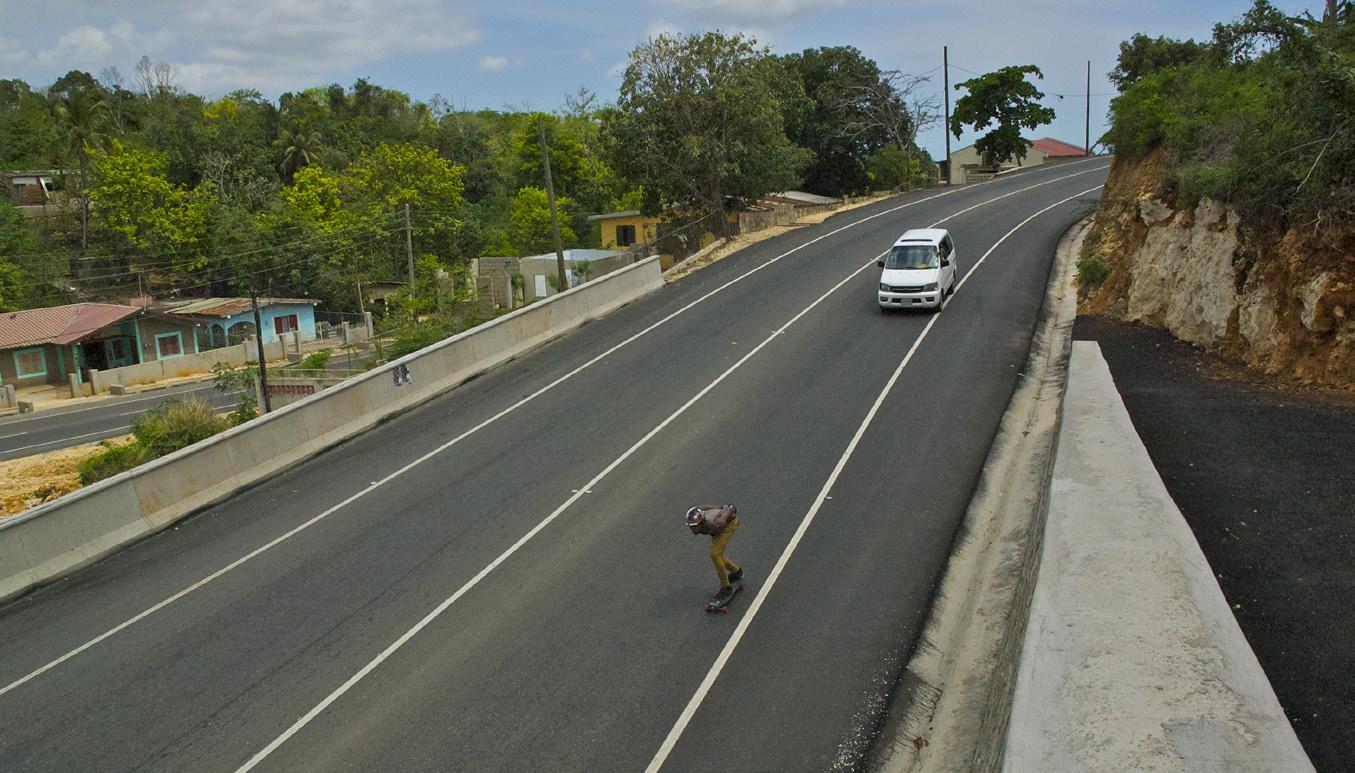


Overa decade ago, Concrete Wave Editions had the privilege of publishing this unique book featuring the photos of Kent Sherwood. Kent was Jay Adams’ stepfather and a gifted amateur photographer. Kent was also the person who introduced Jay to the world of skateboarding and surfing.
It was legendary photographer Glen E. Friedman who initially came to me with the idea of publishing these extraordinary images. Thanks to the generous contribution of Michael Early of Pool King Skateboards, an initial print run of 3,000 copies was produced. While it might be difficult to secure one of those original copies, I am pleased to let you know that the book has received a second life through Universe Publishing.
The book features an introduction by Craig Stecyk and a foreword by Tony Alva. Tony writes, “These photographs are of Jay Adams before life became complicated. They are a time machine. A secret look back into the innocence of Jay that few people ever saw. Angelic on the outside and little devil on the inside.”

Glen’s essay remarks on how Jay was “the seed for so many – one of the originators and great revolutionaries – and he didn’t do any of it on purpose.”
Jay wrote the captions to the photos while he was incarcerated. Two years after the book’s release, Jay was released to a halfway house to finish the remainder of his sentence. Tragically, he passed away in August of 2014 at the age of 53.
Along with photos of Jay, the book features a number of fellow Dogtowners, including Shogo Kubo, Wentzle Ruml IV, Baby Paul Cullen and Tony Alva.
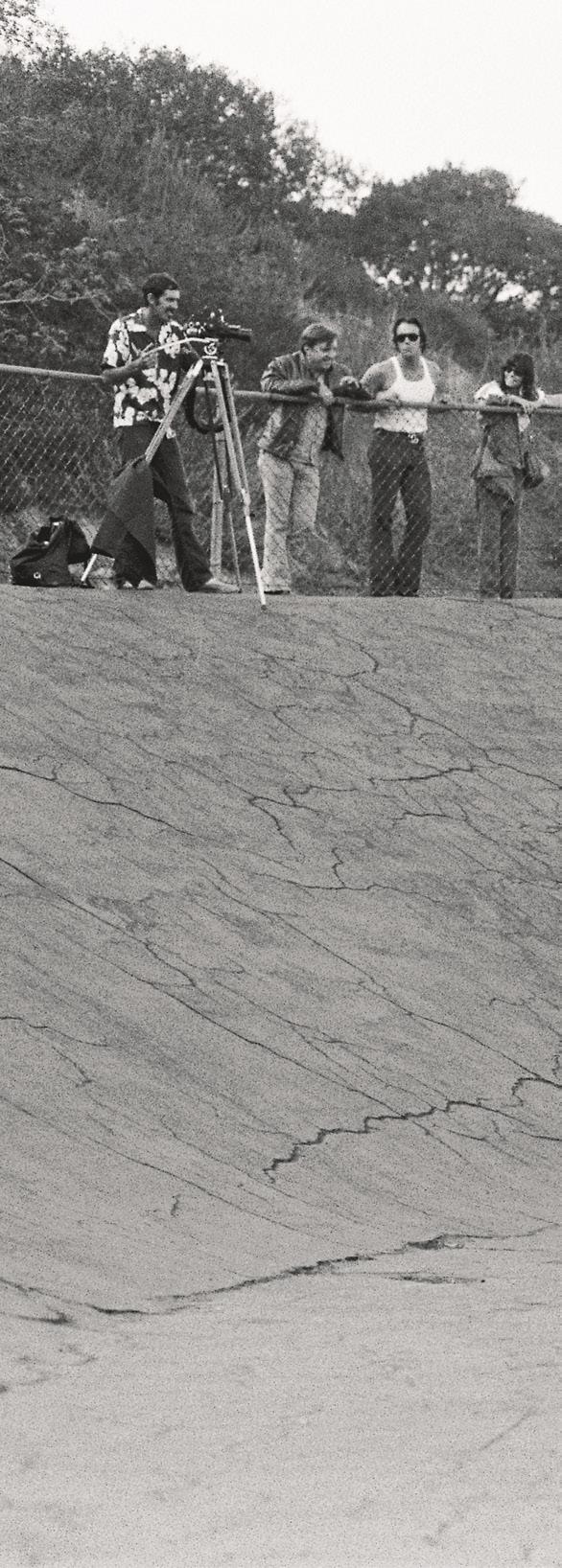
HereJay drops in at Bellagio with Bunker Spreckels and his film crew watching. Bunker is in the tank top.
Above LeftJay spitting sunflower seeds in Venice.



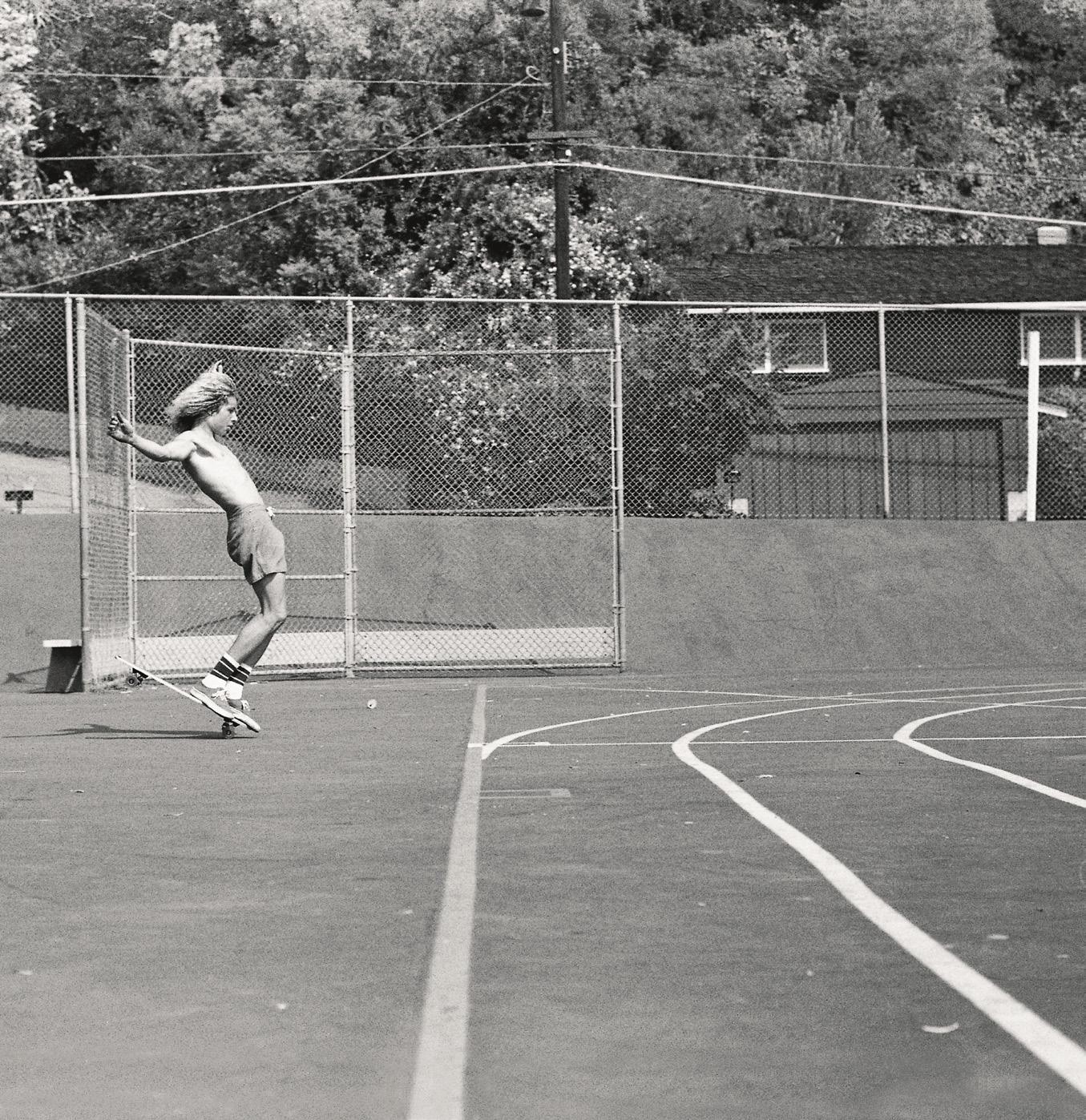

“These photographs are of Jay Adams before life became complicated. They are a time machine. A secret look back into the innocence of Jay that few people ever saw. Angelic on the outside and little devil on the inside.” -Tony AlvaJay performs what he calls a one-legged bert right down the street from his house in Santa Monica.


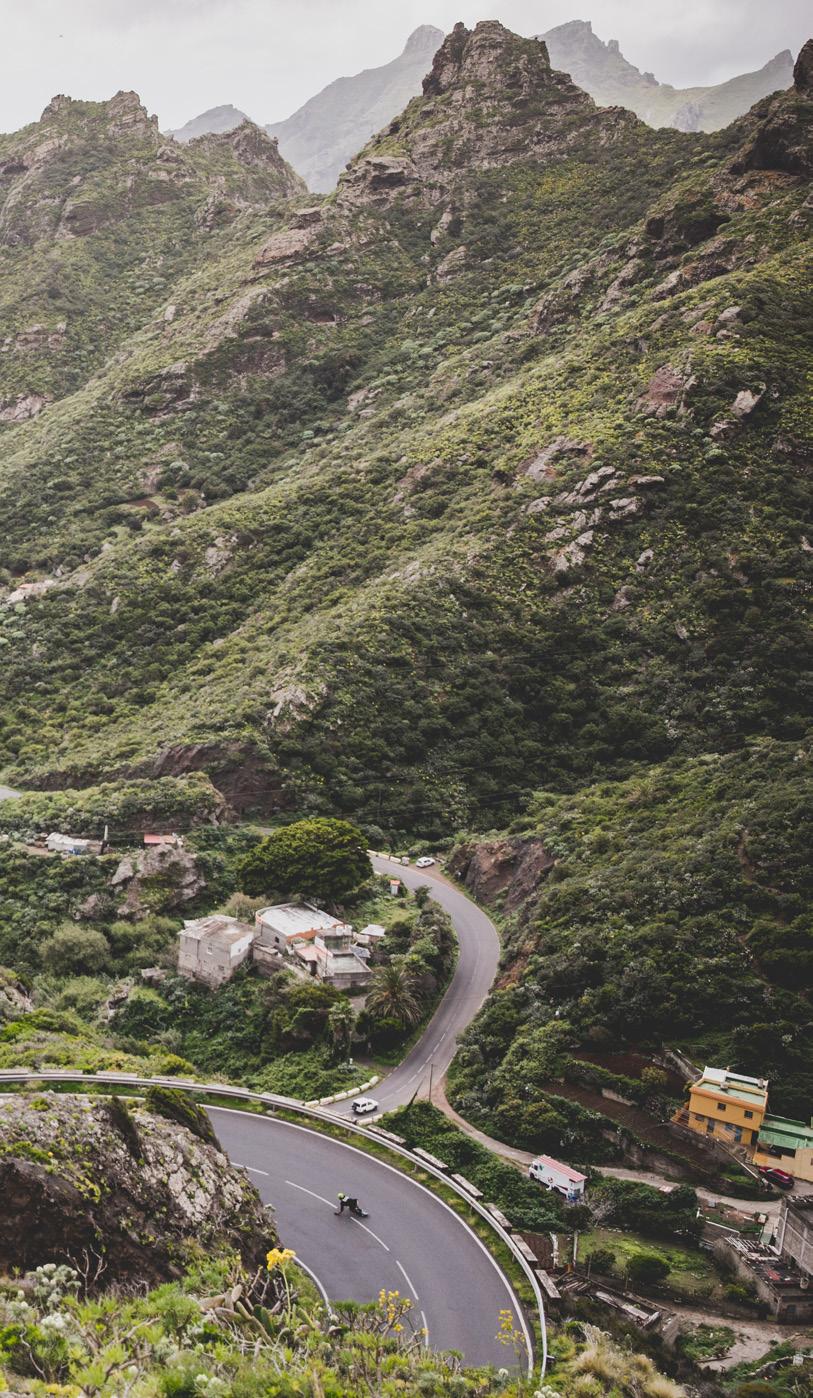
Words and Photos by Felix Pirker
The island of Tenerife is the largest of Spain’s Canary Islands and can be found lurking off the west coast of Africa. Famous for its huge pre-Lent festival and a giant dormant volcano, the island also boasts beaches with sands that range from yellow to black, and a hugely varied landscape that could easily make you think you were on another planet. It is also home to some incredible roads, which was the main reason we were there. Our crew of Mirko Paoloni, Edoardo Bardi, Mariano Conti and Andrea Pedrotti stayed for eight sunny days.
Edo in TagananaOn the south of the island lies the bustling city of Santa Cruz. If you go to or have ever visited Tenerife, there’s a good chance you will start your journey from here. This is where everything comes together for riders: seriously bombable hills above the city, a brand new skatepark designed by one of the X Games park designers and the most active nightlife on the Canary Islands. To top it off, there are surfable breaks too.

 RIGHT Mirko Paoloni in Santa Cruz
FAR RIGHT Mariano in La Martela
BELOW Edo & Sergio in Taganana
RIGHT Mirko Paoloni in Santa Cruz
FAR RIGHT Mariano in La Martela
BELOW Edo & Sergio in Taganana
This spot is always worth a visit and was our first session of the trip before we headed further south to the infamous Anaconda road. Two scenic roads lead down from the beautiful viewpoint at Mirador Las Teresitas; one brings you back down to Santa Cruz and the other one takes you north. The road to Santa Cruz is a mellow scenic cruise about 3 km long.
If you’re having a break up there, though, it might be best to keep your stuff with you and a wary eye on your car. On our first lunch break, a Bastardo inflagranti tried to break into our side window. Mirko spotted him and started shouting and running up to the car. But when questioned, the dude didn’t seem too stressed. He just started mumbling about how he had dropped a joint he had just rolled and was simply trying to find it. Clearly he thought it had fallen inside every car in sight, as all of them had scratch marks on their locks! Another car owner called the police, but the guy somehow wandered off and disappeared before they arrived and subsequently blocked the road, putting an end to our sessions there for the day.
This is certainly the most famous run on the island and a mandatory stop when you are there. The snake lies above a little village called Barranco Hondo and leads up to a handful of little farms. We spent two days filming and skating there with locals Santi Domingorena, Angel Diaz Cano and Sergio Henríquez Insúa.


As you can see from the photograph, the surface of this road is gnarly. Really gnarly. The Anaconda claimed one victim from our crew while we were there. While Mariano was being filmed with the car, Sergio and Mirko took advantage of the shuttle service and took on some heavy full-run battles down the snake’s back. Way ahead of Sergio, Mirko’s board decided to stop while in the middle of a full-speed heelside slide. This put him on the hot seat at about 60 km/h and ejected him pretty much off the road, through bushes and out of sight.
That was one of those moments where everyone collectively thinks, Oh, s--t. We all thought we were going to find him unconscious and seriously f---ed up, but luckily, when we spotted him he was still alive – but very shaken up. Not just mentally either; he was literally shaking. Blasting off the road at 60 km/h will do that to you. A trip to the hospital revealed a broken ankle that unfortunately put him out of action for the rest of the trip. The skin of this monster anaconda is definitely peeling off, so if you want to hit it, you’d better come sooner rather than later – and bring some strong willpower with you!
Probably the nicest name a bus stop could ever have, and also a fitting name for a fast and dry road, which Mariano and Sergio particularly enjoyed blasting down. The surface of El Bueno is really smooth, and it features a lot of corners as well as a breathtaking view over the Atlantic Ocean and the neighboring island of La Gomera. This year there will also be a BigMountainSkate competition for the first time at this spot.
This is where we called home during our stay on Tenerife. It is definitely a lot quieter than Santa Cruz, but in return it offers some more down-to-earth local bars and some of the best bocadillos around. You can fill your stomach with these amazing sandwiches for a very good price. As with Santa Cruz, there are also good surf spots along the coast to the north and south of the city. The famous surf spot Playa de Socorro is 30 minutes north from here.

This is the highest mountain in the whole of Spain, located in Tenerife and on the same latitude as Morocco. It’s also a dormant volcano! The winding mountain drive up there from our home in Puerto de la Cruz took us about 90 minutes. But it’s definitely worth having your camera ready, as this is one of the most remarkable drives on the island. It brings you from sea level to 3559 meters above it, through a landscape that could easily make you think you’ve traveled to another planet. The white mushroom-looking observatories dotted over the hills certainly add to this effect. The road surface that descends from the observatory is pretty rough and features the sort of giant cracks that seem guaranteed to trap you and your wheels. Once up on top, Edoardo and Mariano grabbed their boards from the car and started to shred, undeterred by the hungry mouths beneath them. Thankfully, there were no repeats of the Anaconda incident, and we came away with some mad photos and huge smiles.
From El Teide we took the south route down from the volcano, which brought us to the village of Vilaflor. Onward from Vilaflor, the road surface vastly improved and we found ourselves cruising a freshly surfaced and mellow freeride track through pine woods. This is one of those simple but wonderful spots where you can just enjoy cruising a chilled road with a beautiful view. What more could you ask for?
You could also have a little break at the bus stop of La Martela. There’s a high chance of running into some of the locals there, as it’s the best spot to park and turn cars when skating. From there you can enjoy the last 6 km down the road, which for the most part is facing the sunset. While there, by chance we ran into Angel, who then brought us to the Sliders House for beers in the evening.
Seaside

On the southwest side of Tenerife, in a town called Adeje, there’s a house called the Sliders House. As you can probably guess from the name, it’s a refuge for skaters. We were warmly welcomed by Martin and his team. We gratefully received a tip about a road nicknamed Seaside, a place definitely worth its name. This is a steep road with a deep black surface that simply begs for thane lines. Edo and Mariano happily obliged and proceeded to paint their lines on the blank canvas with Edo effortlessly throwing down squats all day. We had no problems with traffic and were completely alone for the first half of the day before some new friends we made at the Sliders House the previous evening showed up in the afternoon and joined our session.
Taganana
This road lies on the north face of the Anaga Mountains and is easy to reach from Santa Cruz. At a very rough guess, it’s about 40 km long and winds its way through the humid Tenerife jungle. At some points the gradient of this seemingly endless road can reach 16 percent, but it is very easy to spot cars and is a great road to ride. Just make sure to keep an eye out for cyclists, as they also like to roam around here.
